Transitional living rooms represent the perfect marriage between classic elegance and contemporary functionality, creating spaces that feel both timeless and current. This versatile design approach allows homeowners to blend traditional comfort with modern sophistication, resulting in rooms that accommodate both formal entertaining and casual family life. By combining neutral color palettes with carefully selected statement pieces, mixing various textures and materials, and balancing masculine and feminine elements, transitional style creates harmonious environments that evolve with changing trends while maintaining their foundational appeal. These design concepts focus on practical layouts, comfortable furnishings, and thoughtful accessories that reflect personal style within a cohesive aesthetic framework.

1. Neutral Foundation with Warm Wood Accents
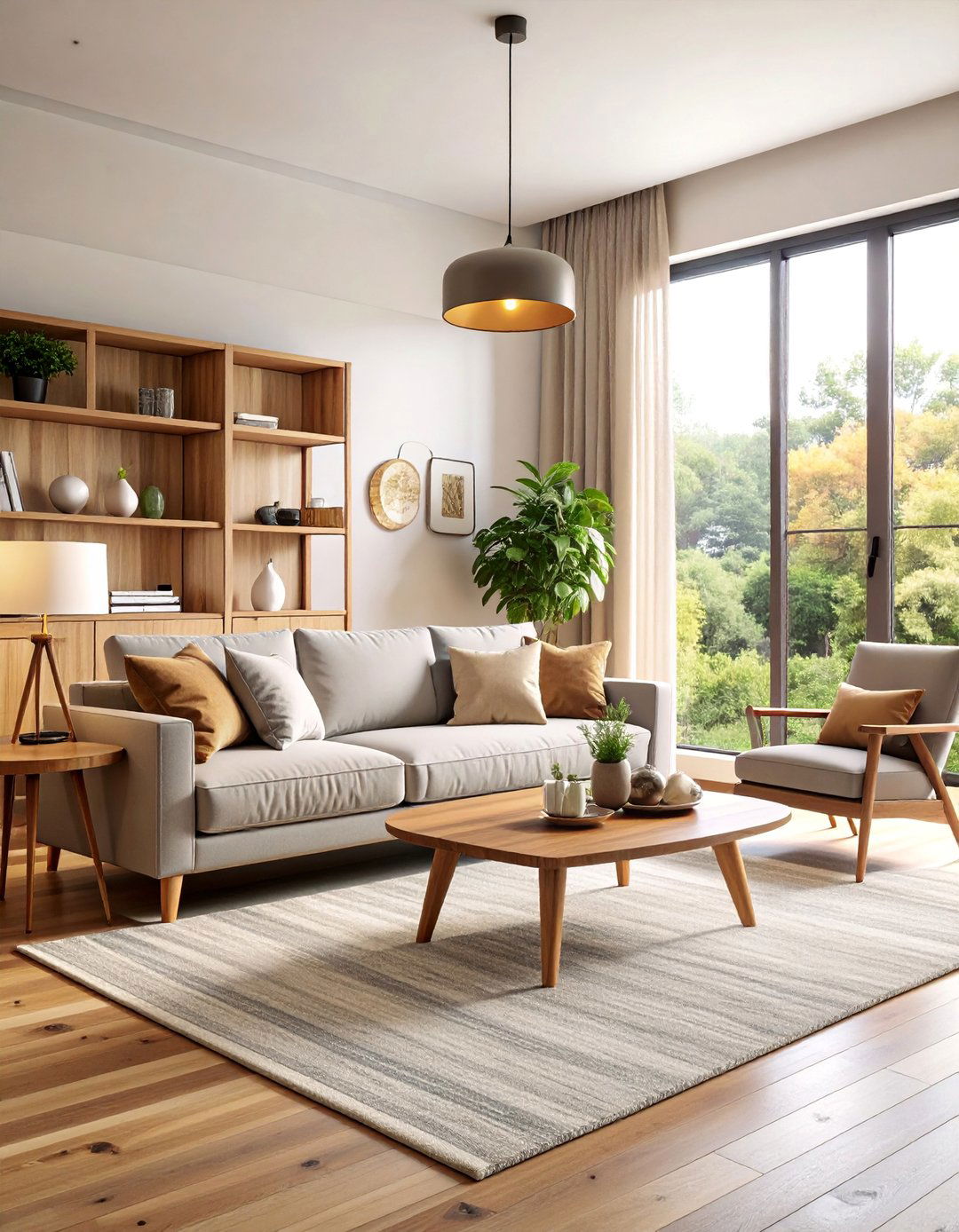
Anchoring your transitional living room with a neutral color scheme of soft grays, warm beiges, and creamy whites creates a serene backdrop for mixing design elements. Introduce rich wood tones through a reclaimed coffee table, walnut side tables, and natural oak built-in shelving to add warmth and organic texture. The wood elements should bridge traditional craftsmanship with contemporary clean lines, featuring simple geometric shapes and smooth finishes. Layer in linen upholstery, wool throws, and leather accent chairs to create depth. This approach allows artwork and decorative accessories to become focal points while maintaining a sophisticated, lived-in atmosphere that works for both entertaining guests and daily family activities.
2. Modern Sectional with Traditional Rug Design

Create visual harmony by pairing a sleek, contemporary sectional sofa in charcoal gray with an ornate Persian or oriental rug featuring rich burgundy and gold tones. This juxtaposition exemplifies transitional design's core principle of balancing old and new elements. Choose a sectional with clean lines and structured cushions, then soften the modern geometry with a vintage-inspired area rug that adds pattern and historical reference. Complete the look with brass table lamps, ceramic accent pieces, and throw pillows in complementary jewel tones. The rug anchors the seating area while the modern furniture keeps the space feeling current, creating a sophisticated dialogue between eras that feels both comfortable and refined.
3. Built-In Entertainment Center with Mixed Materials
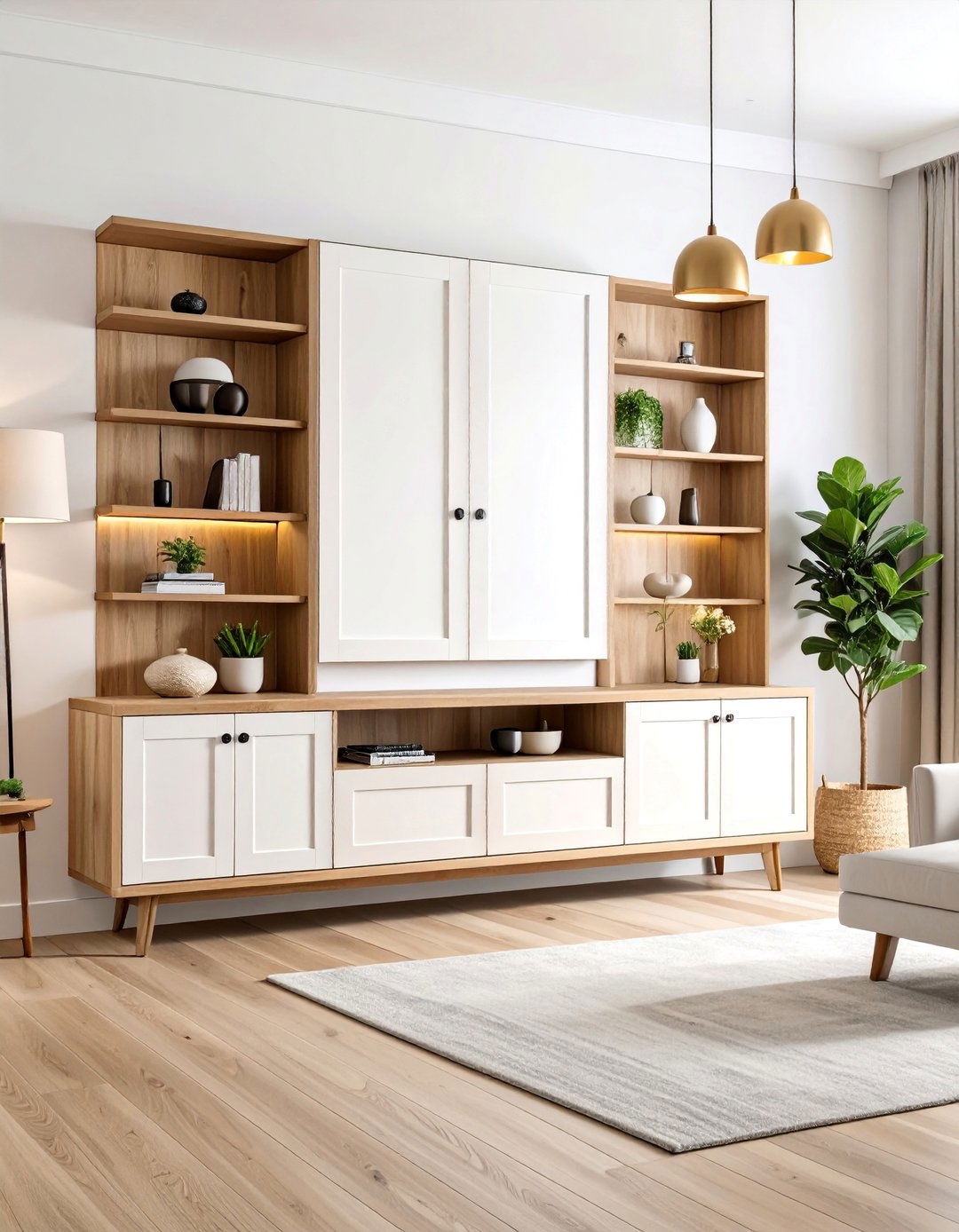
Design a custom entertainment center that combines traditional cabinetry with contemporary media needs, featuring white-painted shaker-style doors paired with natural wood open shelving and black metal hardware. This built-in approach maximizes storage while maintaining clean lines and visual balance. Incorporate closed storage for electronics and everyday items, while displaying books, decorative objects, and family photos on open shelves. Add interior lighting to highlight displayed items and create ambient atmosphere. The mixed materials of painted wood, natural timber, and metal accents represent transitional style's ability to blend textures and finishes. Surround the entertainment center with comfortable seating arranged to facilitate both television viewing and conversation, ensuring the space serves multiple functions seamlessly.
4. Fireplace Focal Point with Symmetrical Seating

Center your transitional living room around a classic fireplace with a white or natural stone surround, flanked by matching built-in bookcases for perfect symmetry. Create a formal seating arrangement with two identical armchairs positioned facing each other, anchored by a large area rug and complemented by a sofa perpendicular to the fireplace. Choose furniture with traditional silhouettes updated in contemporary fabrics like linen or performance textiles in neutral tones. Add brass or bronze accessories, including candlesticks, picture frames, and table lamps, to enhance the refined atmosphere. This layout encourages intimate conversation while highlighting the fireplace as the room's architectural centerpiece, blending formal traditional elements with comfortable, livable modern functionality.
5. Mixed Texture Layering Approach
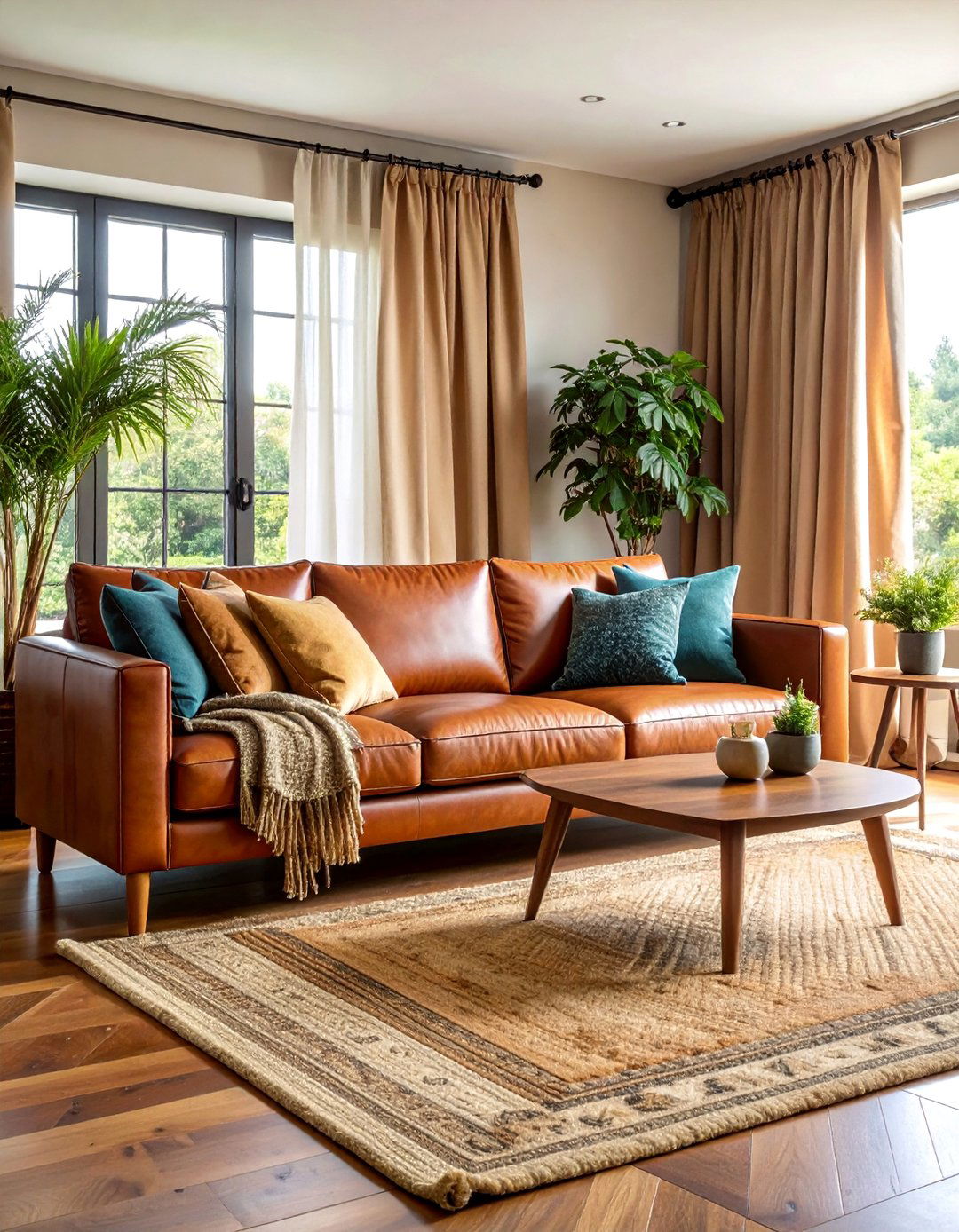
Embrace transitional design's emphasis on texture by layering diverse materials throughout your living space, combining smooth leather seating with nubby wool throws, silk curtains, and jute area rugs. Start with a leather sofa in rich cognac or warm gray, then add velvet accent pillows and a chunky knit throw for contrast. Install linen Roman shades at windows and place a natural fiber rug beneath seating areas. Incorporate wood furniture pieces with different finishes, from weathered oak to polished walnut, alongside ceramic lamps and brass hardware. This textural diversity creates visual interest and tactile appeal while maintaining the neutral color palette essential to transitional style, resulting in a space that feels sophisticated yet inviting.
6. Open Concept with Defined Zones

In an open floor plan, create distinct living areas using furniture placement and area rugs to define spaces while maintaining visual flow. Position a large sectional to separate the living area from dining space, with its back serving as a natural room divider. Use coordinating but different area rugs to anchor each zone, ensuring they complement the overall color scheme. Choose furniture pieces that relate to each other through similar materials or colors but serve different functions. Add a console table behind the sofa for additional surface space and visual weight. This approach creates intimacy within larger spaces while preserving the open, airy feel that makes transitional design so appealing for modern family living.
7. Monochromatic with Varied Textures
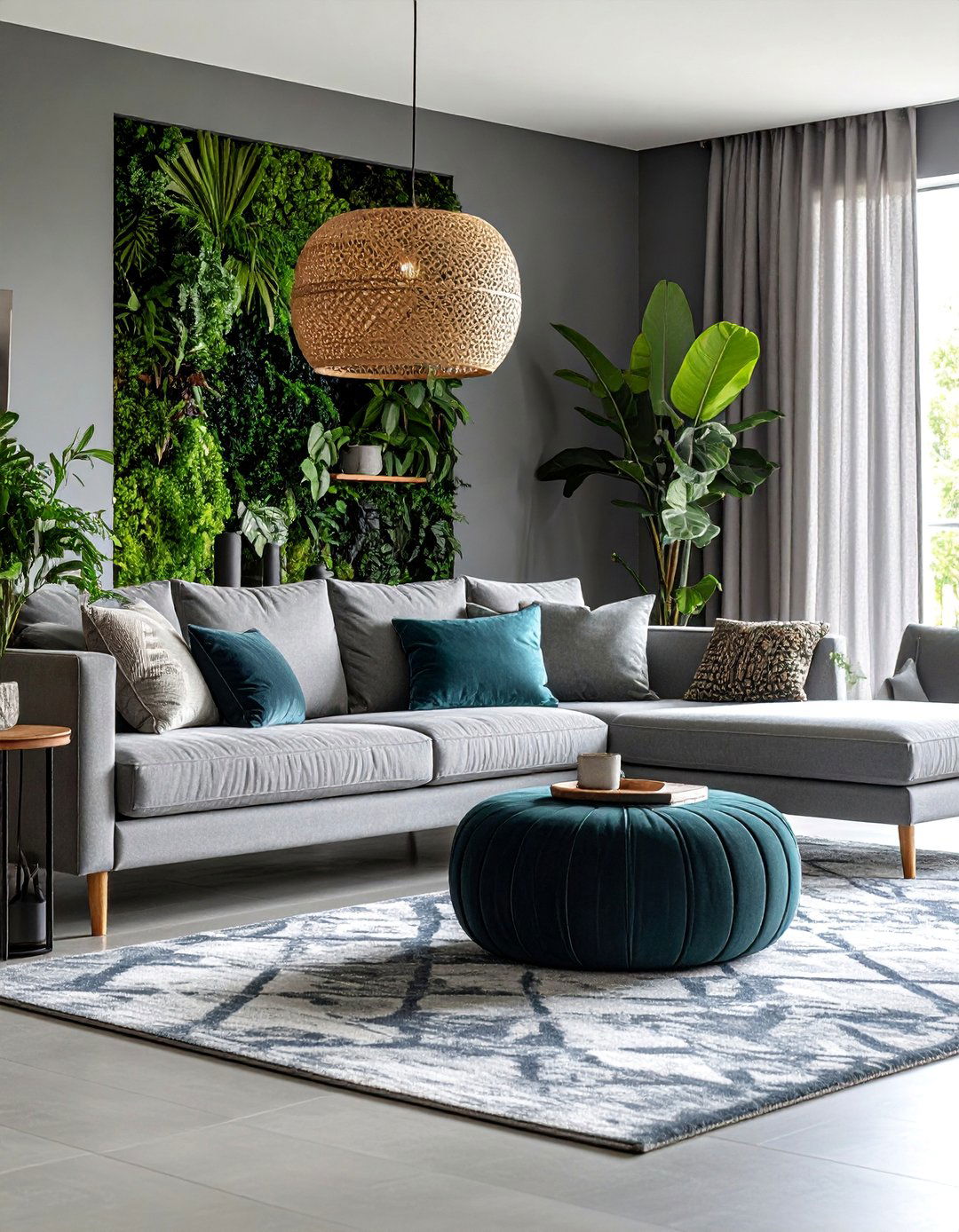
Develop a sophisticated monochromatic living room using varying shades of gray, from pale dove to deep charcoal, differentiated through texture rather than color. Choose a light gray sectional with smooth fabric, pair it with a darker gray velvet ottoman, and add throws in bouclé or cable knit. Install grasscloth wallpaper in warm gray tones and layer different textures through accessories like ceramic vases, woven baskets, and metal picture frames. The monochromatic approach creates a serene, sophisticated atmosphere while the varied textures prevent the space from feeling flat or monotonous. Add warmth through brass lighting fixtures and natural wood accents to prevent the gray palette from feeling cold, achieving the balanced comfort essential to transitional design.
8. Statement Lighting with Classic Furniture

Make lighting the focal point by installing a dramatic chandelier or pendant light fixture above the seating area, combining traditional furniture pieces with contemporary illumination. Choose a brass or black metal fixture with clean lines and geometric shapes to contrast with classic furniture silhouettes like rolled-arm sofas and wingback chairs. The lighting should feel modern and sculptural while the furniture maintains traditional comfort and proportions. Add table lamps with ceramic or marble bases and linen shades for layered lighting that serves both ambient and task purposes. This approach demonstrates how transitional design can highlight individual elements while maintaining overall harmony, creating spaces that feel both current and timeless through strategic contrast and balance.
9. Window Treatment Focal Design
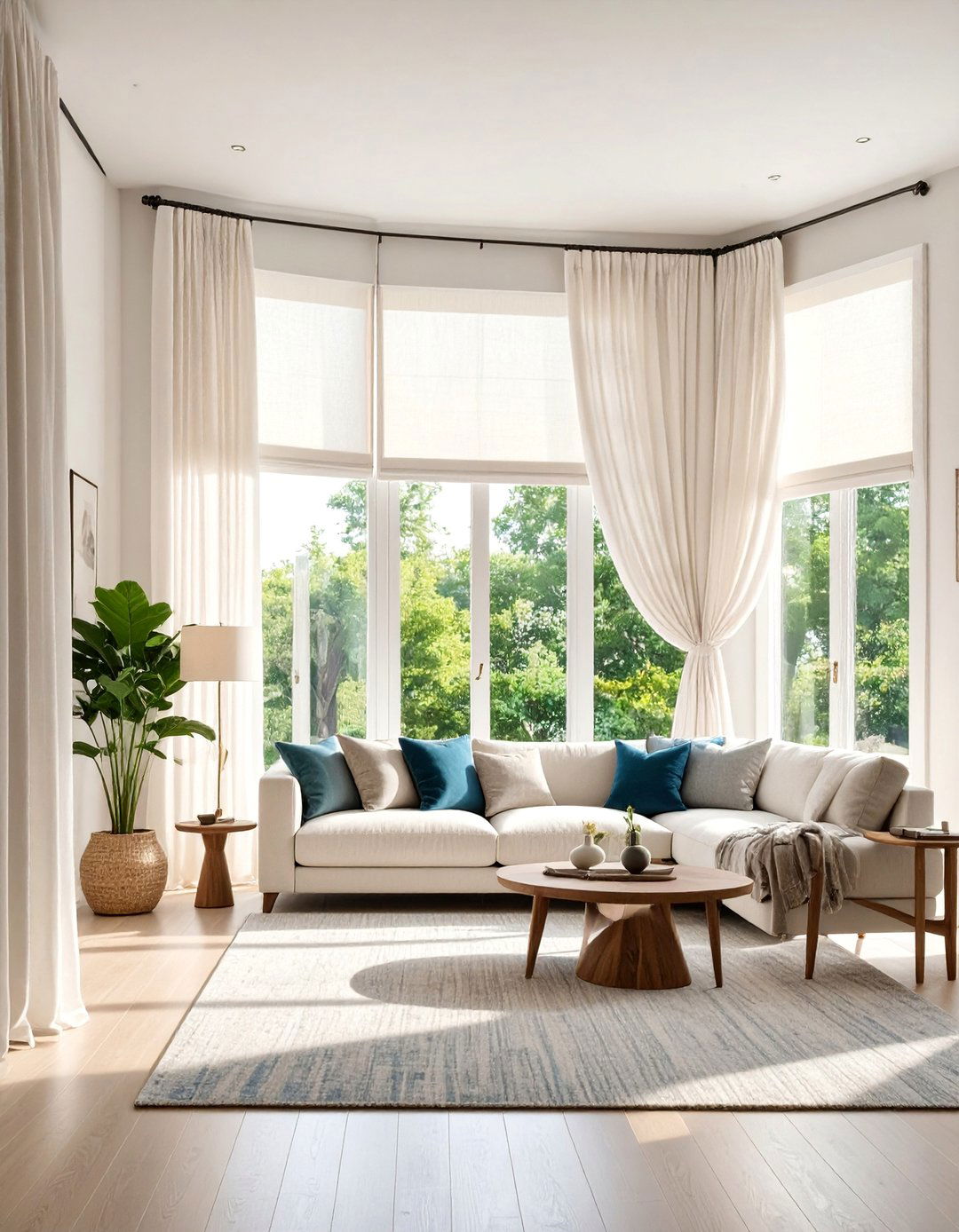
Transform windows into design statements using floor-to-ceiling curtains in luxurious fabrics that bridge traditional and contemporary styles. Choose natural linen panels in soft white or warm gray, hung from ceiling to floor to maximize visual height and create dramatic vertical lines. Layer with Roman shades in complementary patterns or textures for light control and added visual interest. The window treatments should feel substantial and elegant while maintaining the clean lines essential to transitional design. Coordinate the fabric choices with other textiles in the room, including throw pillows and upholstery, to create cohesive flow. This approach adds softness and warmth while making windows architectural features that enhance the room's overall sophistication and comfort.
10. Gallery Wall with Transitional Furniture

Create a curated gallery wall combining traditional oil paintings, contemporary photography, and vintage prints in coordinating frames, positioned above classic furniture with modern proportions. Choose frames in consistent materials like brass, black metal, or natural wood to unify diverse artwork styles. Position the gallery wall behind a sofa with traditional rolled arms but contemporary scale and cushioning. Add symmetrical table lamps and carefully arranged accessories to complement the wall display. This approach showcases personal collections while demonstrating transitional design's ability to blend different periods and styles cohesively. The artwork adds personality and visual interest while the coordinated furniture and accessories maintain the sophisticated balance characteristic of transitional interiors.
11. L-Shaped Seating Arrangement
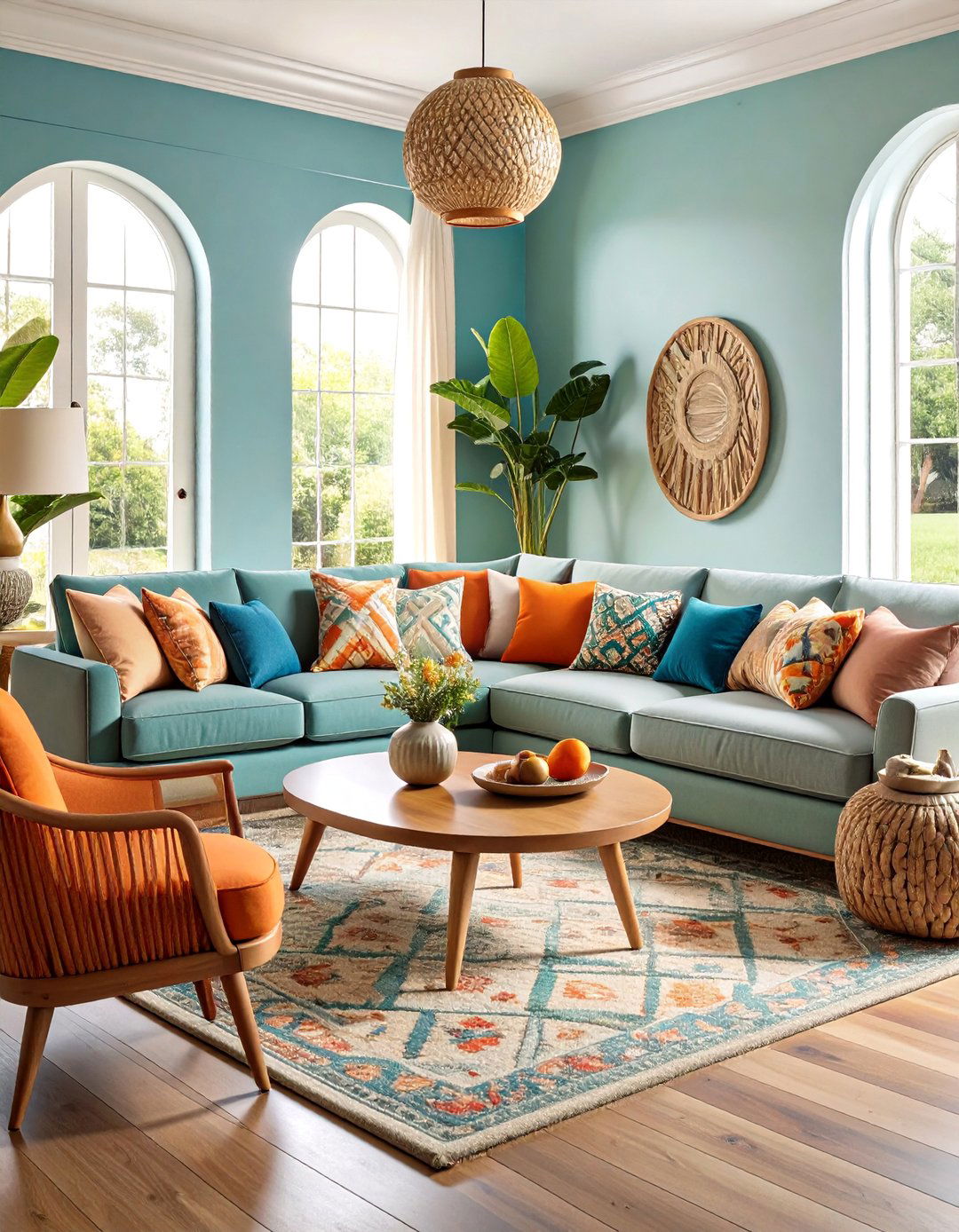
Design an intimate conversation area using an L-shaped furniture arrangement that combines a traditional sofa with contemporary accent chairs, creating natural traffic flow while encouraging social interaction. Position a classic three-seat sofa perpendicular to two modern armchairs, with a large coffee table anchoring the arrangement. Choose upholstery in coordinating neutral tones but vary the textures, perhaps linen for the sofa and leather for the chairs. Add side tables at each seating position for functionality and visual balance. This layout works particularly well in square rooms, creating cozy conversation zones while maintaining the open, uncluttered feel essential to transitional design, demonstrating how furniture arrangement can define space effectively.
12. Two-Tone Color Scheme

Develop a sophisticated two-tone palette using warm white and soft gray throughout the living space, creating depth through varying shades rather than multiple colors. Paint walls in warm white while choosing furniture and accessories in different gray tones, from pale silver to deep charcoal. This approach allows for easy updates through accessories while maintaining a timeless foundation. Add natural wood accents and brass fixtures to warm the cool palette and prevent it from feeling stark. The two-tone scheme creates visual cohesion while allowing individual pieces to stand out through texture and form rather than color contrast, exemplifying transitional design's emphasis on subtle sophistication and enduring appeal rather than trendy color combinations.
13. Vintage and Modern Art Mixing
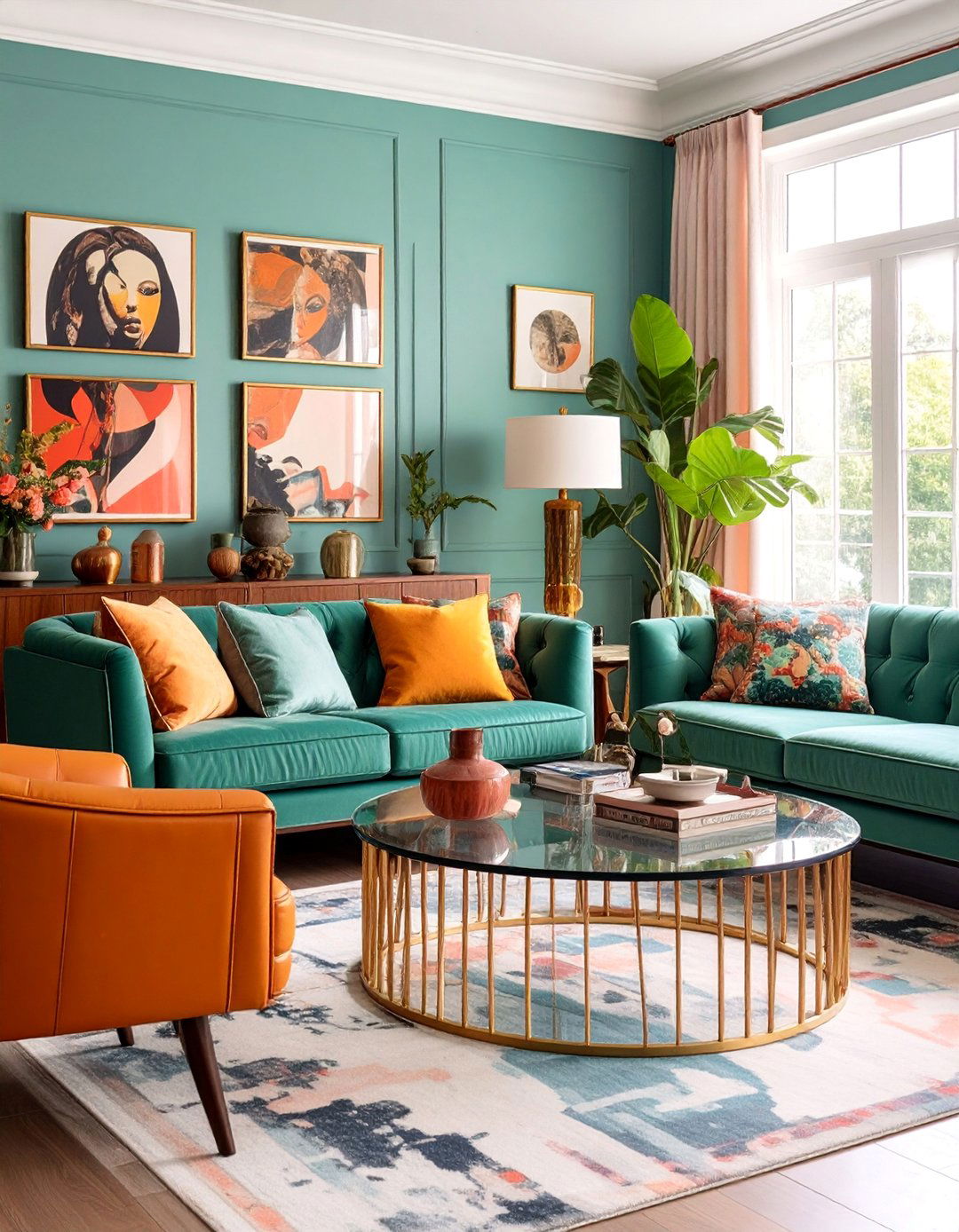
Combine antique portraits or traditional landscapes with contemporary abstract pieces, creating an eclectic art collection that reflects transitional design's blend of old and new. Frame pieces in similar materials to create cohesion despite different artistic periods and styles. Position artwork thoughtfully around the room, balancing traditional pieces with modern works to avoid clustering similar styles together. Choose furniture that complements the art's diverse character, perhaps a vintage leather chair paired with a contemporary glass coffee table. This approach personalizes the space while demonstrating how transitional design accommodates diverse tastes and collections, creating rooms that feel curated and sophisticated while remaining comfortable for daily living.
14. Coastal Transitional Blend
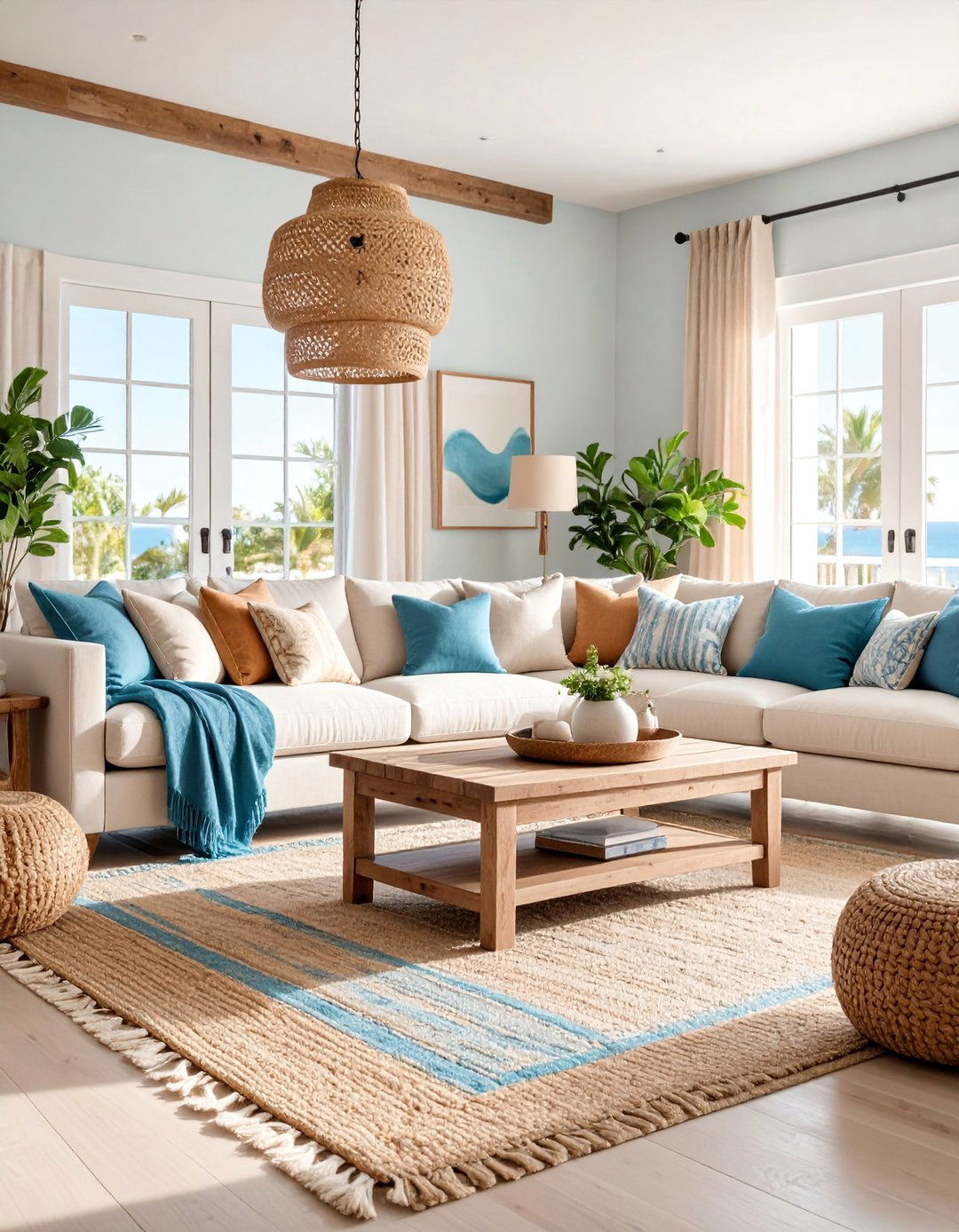
Incorporate coastal elements through natural materials and soft blues while maintaining transitional design sophistication, avoiding overtly nautical themes in favor of subtle seaside inspiration. Choose furniture in weathered wood finishes and natural linen upholstery in sandy beiges and ocean blues. Add texture through jute rugs, rope details, and ceramic accessories in seafoam and coral tones. Large windows should showcase natural light while gauzy curtains provide privacy without blocking views. This approach creates a relaxed, vacation-like atmosphere while maintaining the refined balance essential to transitional design. The coastal influence adds personality and regional character while sophisticated material choices and clean lines prevent the space from feeling too themed or casual.
15. Dark Accent Wall with Light Furniture
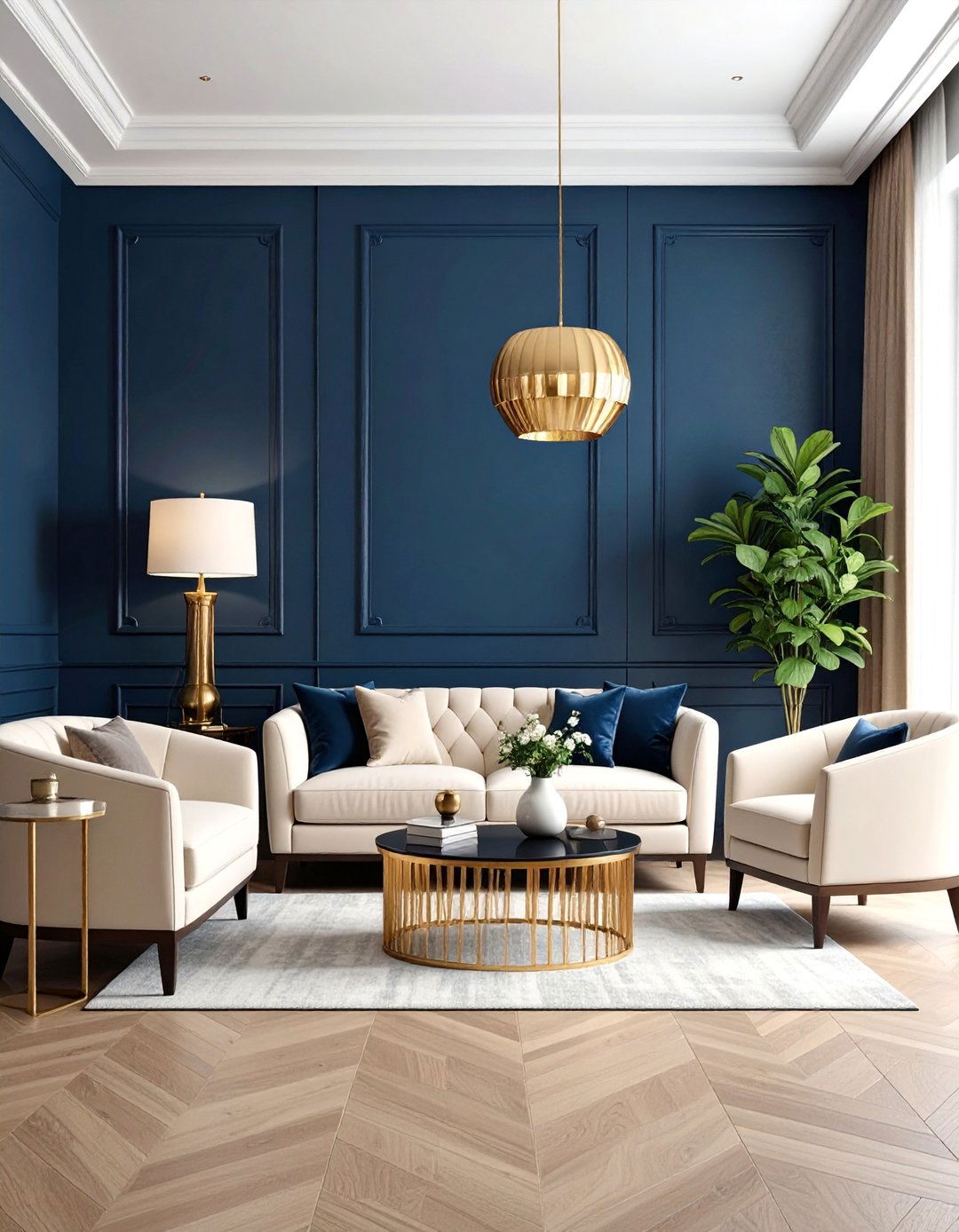
Create dramatic contrast by painting one wall in deep navy or charcoal while keeping remaining walls and furniture in light, neutral tones, demonstrating transitional design's ability to incorporate bold elements within balanced compositions. Choose the wall behind the sofa or fireplace for maximum impact, then furnish with cream or white upholstered pieces to create striking contrast. Add brass or gold accents through lighting and accessories to warm the dark backdrop and prevent it from feeling heavy. This approach adds visual weight and sophistication while maintaining the light, airy feel essential to transitional interiors, proving that dramatic elements can enhance rather than overwhelm when used strategically within neutral foundations.
16. Symmetrical Built-Ins Around Fireplace
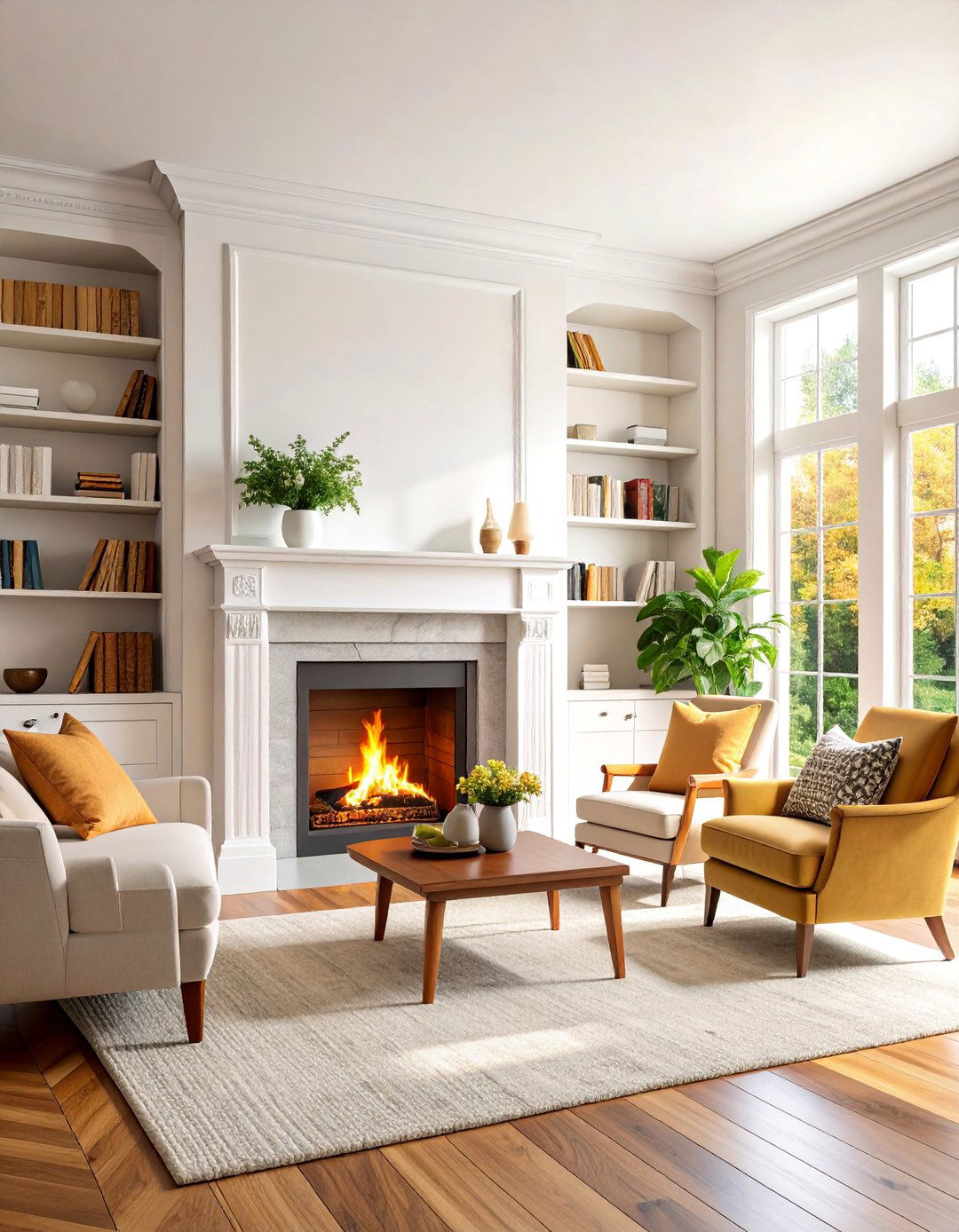
Frame a traditional fireplace with matching built-in bookcases and cabinets, creating perfect symmetry that anchors the room while providing extensive storage and display space. Design the built-ins with classic details like crown molding and panel doors, painted in crisp white to maintain clean lines. Style the shelves with books, decorative objects, and family photos, maintaining visual balance through careful arrangement. Add comfortable seating facing the fireplace to create a natural gathering space. This approach combines traditional architectural elements with contemporary functionality, providing beautiful storage solutions while creating a focal point that enhances the room's classic elegance and ensures the space serves both aesthetic and practical purposes effectively.
17. Curved and Angular Furniture Mix
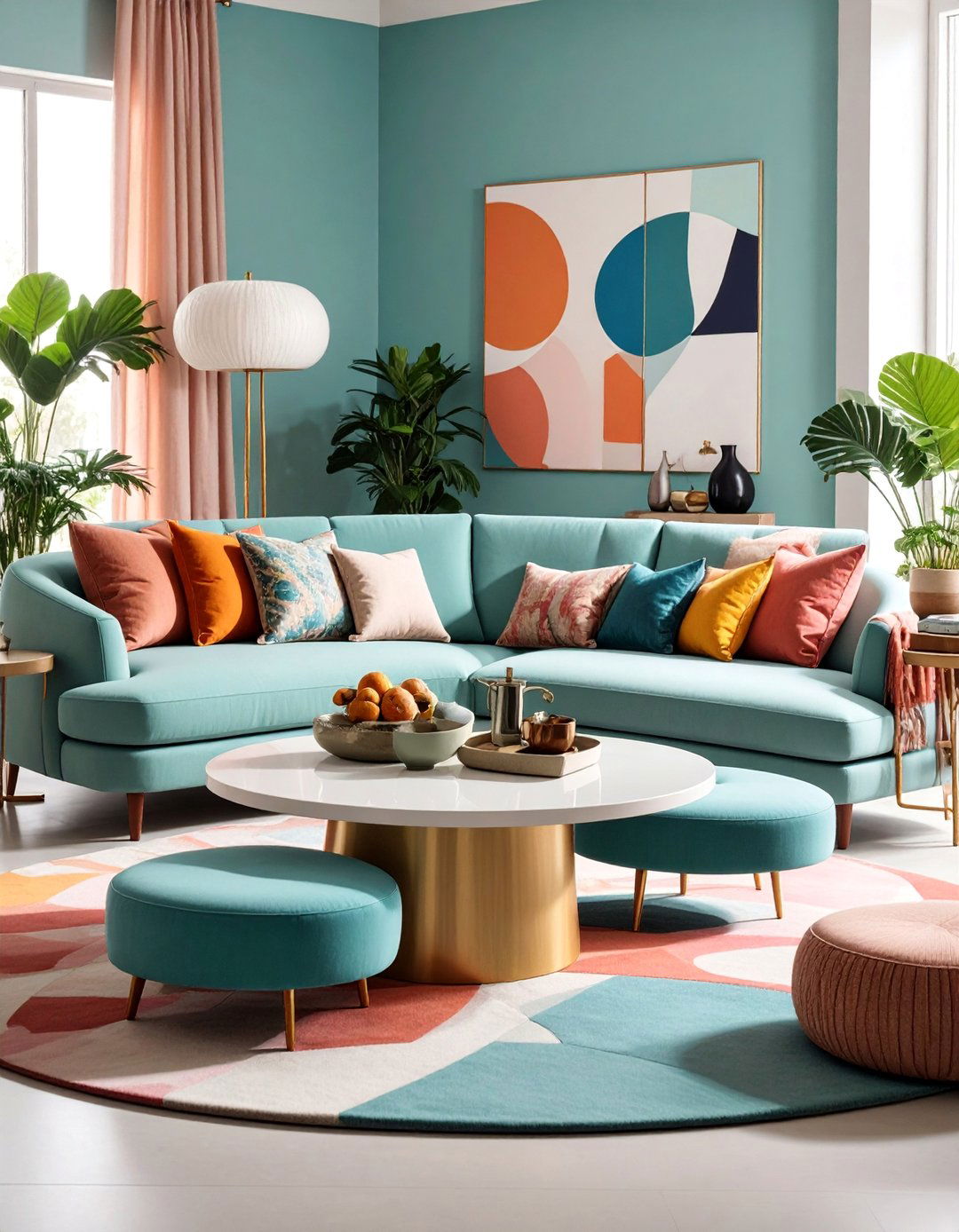
Balance the visual composition by mixing furniture with curved lines, like a round coffee table and upholstered ottoman, with angular pieces such as a structured sectional and rectangular side tables. This combination creates dynamic visual interest while maintaining the harmony essential to transitional design. Choose pieces in coordinating materials and colors to ensure cohesion despite different shapes and forms. The curved elements soften the space and encourage traffic flow, while angular pieces provide structure and define seating areas. Add accessories that bridge both design approaches, such as ceramic vases with organic shapes and geometric throw pillows, creating a sophisticated balance that feels both comfortable and visually engaging.
18. Jewel Tone Accent Approach
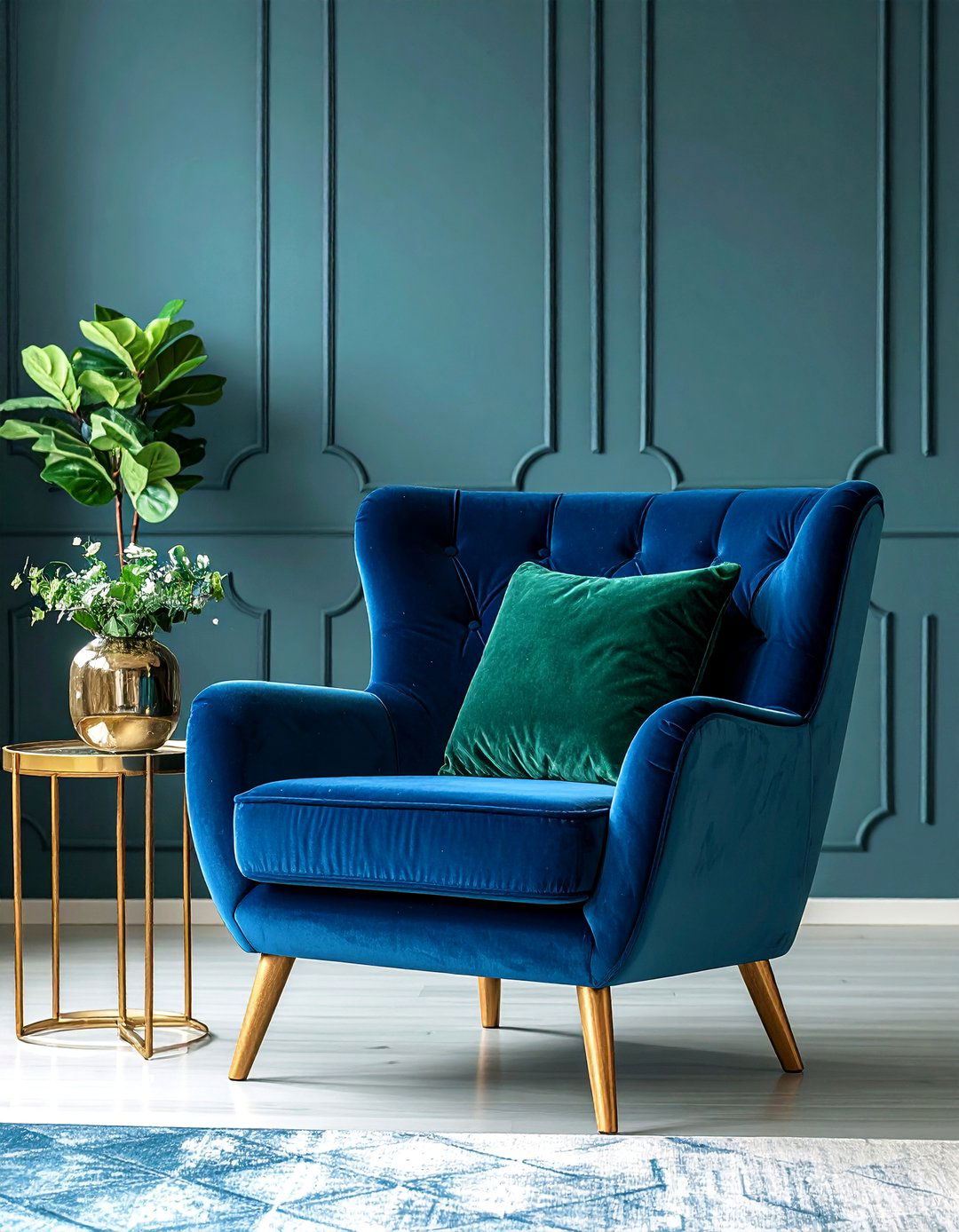
Introduce rich jewel tones like sapphire blue, emerald green, or deep burgundy through carefully chosen accent pieces against a neutral foundation, adding luxury and depth without overwhelming the transitional aesthetic. Use jewel tones sparingly in throw pillows, artwork, or a single statement chair, allowing the rich colors to create focal points within the calm neutral palette. Choose materials like velvet or silk that enhance the jewel tones' luxurious qualities while maintaining sophisticated restraint. This approach adds personality and warmth while demonstrating how transitional design can accommodate bold elements when used judiciously, creating spaces that feel both refined and welcoming while maintaining the timeless appeal that defines this versatile style.
19. Natural Materials Focus
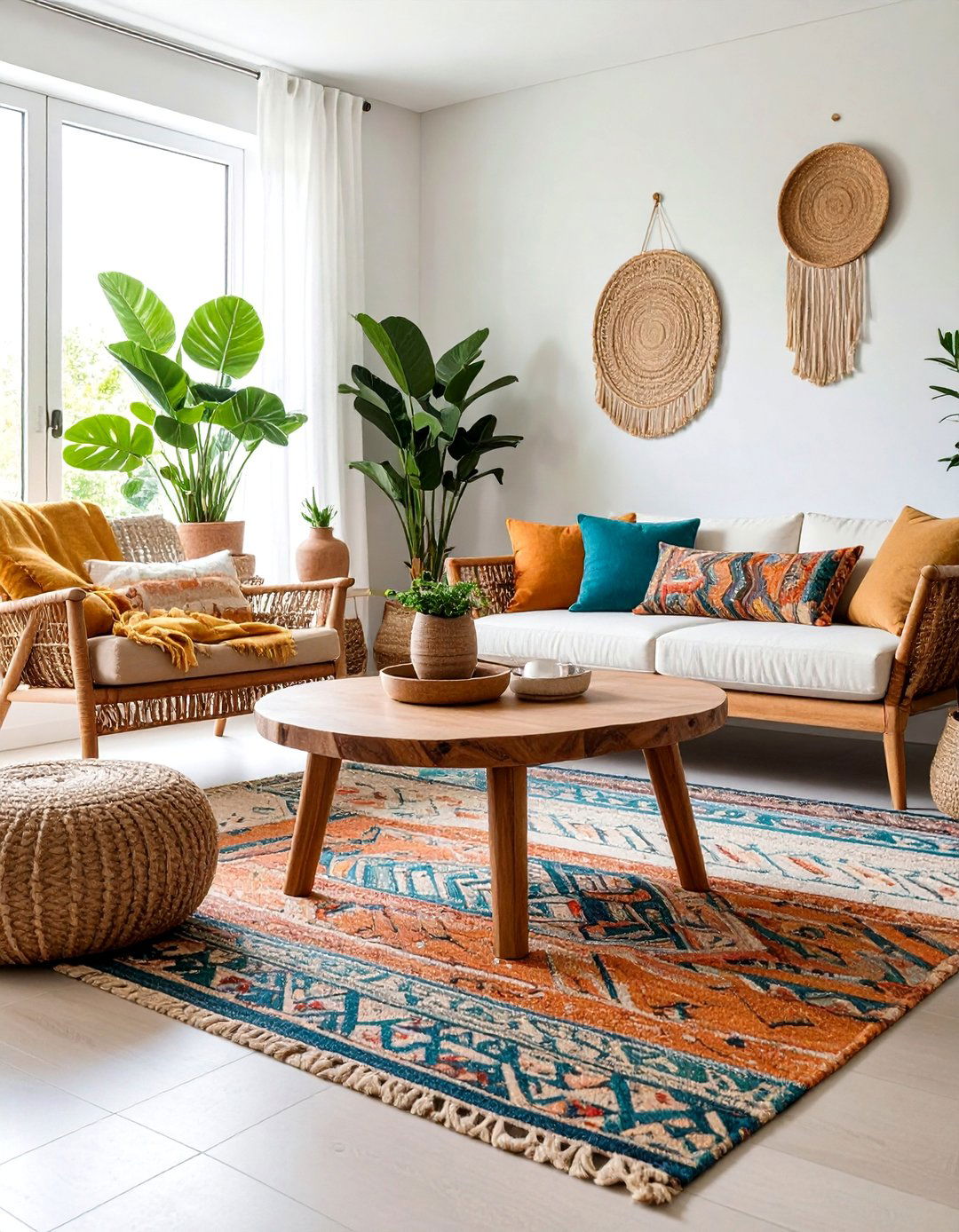
Emphasize organic materials throughout the living space, combining reclaimed wood furniture, natural stone accents, and fiber textiles to create warmth and authentic character within the transitional framework. Choose a live-edge coffee table, woven jute rugs, and linen upholstery to celebrate natural textures and variations. Add potted plants and fresh flowers to enhance the organic feeling while maintaining clean, uncluttered lines. The natural materials should feel sophisticated rather than rustic, with refined finishes and contemporary proportions that honor the materials' inherent beauty while fitting seamlessly into modern living. This approach creates spaces that feel grounded and serene while maintaining the polished appearance essential to transitional design.
20. Formal and Casual Furniture Blend

Mix traditionally formal pieces like a Chesterfield sofa or wingback chairs with casual elements such as an oversized ottoman or relaxed sectional, creating a living space that accommodates both entertaining and family relaxation. Choose refined materials like leather and linen that work in both formal and casual contexts, ensuring visual cohesion despite different furniture styles and purposes. This approach allows the room to serve multiple functions while maintaining sophisticated appearance, demonstrating transitional design's practical versatility. Add accessories that bridge formal and casual aesthetics, such as elegant table lamps with relaxed ceramic bases, creating spaces that feel both polished and comfortable for everyday living.
21. Layered Lighting Design

Create comprehensive lighting schemes using multiple sources including ambient ceiling fixtures, task table lamps, and accent sconces to ensure the living space functions beautifully throughout different times of day and various activities. Combine traditional lamp styles with contemporary fixtures, such as classic ceramic table lamps paired with modern brass sconces. Install dimmer switches to control mood and functionality. The layered approach should provide both practical illumination and atmospheric lighting while maintaining the sophisticated balance essential to transitional design. Choose fixtures in coordinating materials and finishes to ensure cohesion despite different styles and purposes, creating spaces that feel warm and inviting while serving all necessary functions effectively.
22. Storage-Focused Design
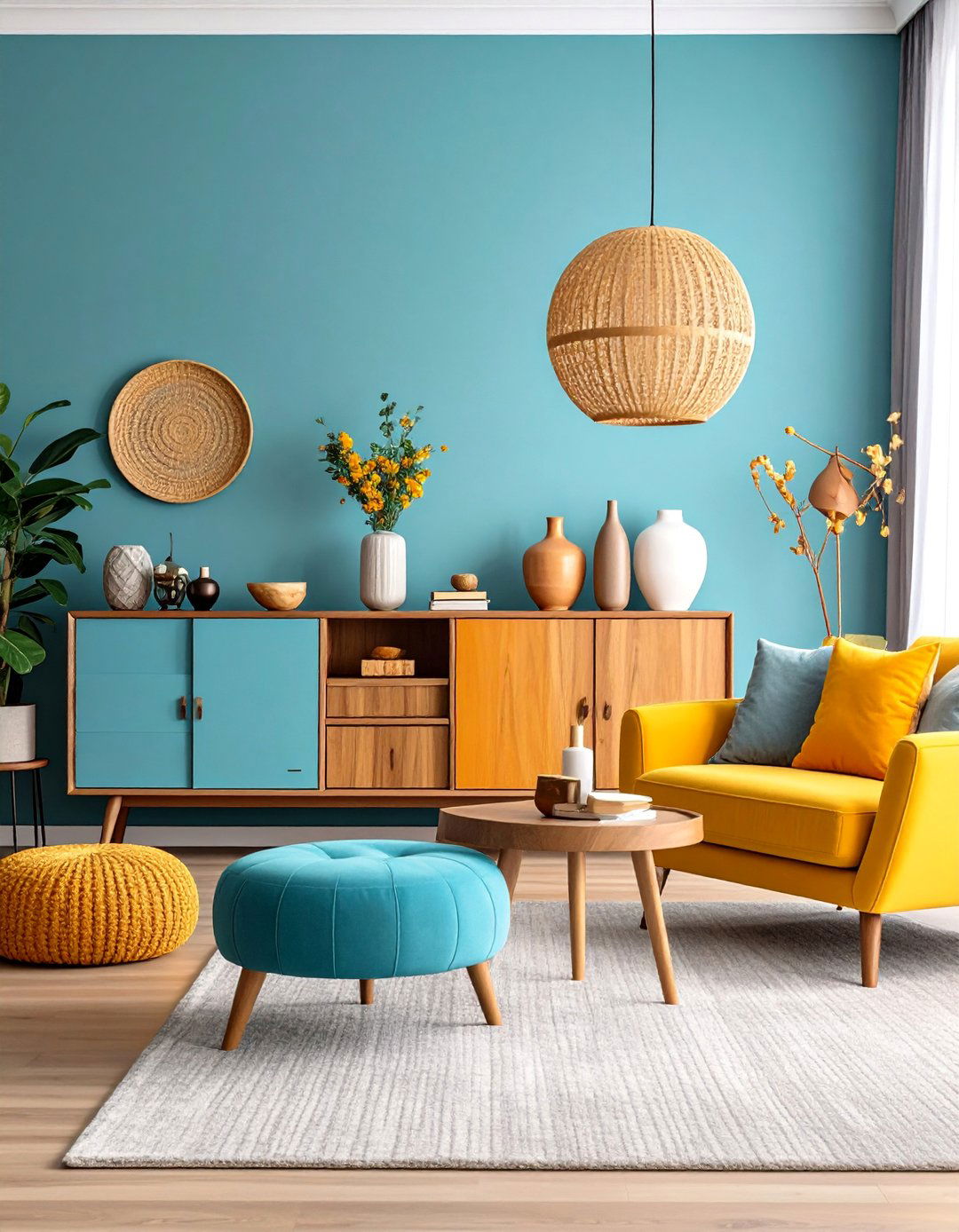
Integrate abundant storage solutions seamlessly into the transitional living room design through built-in cabinets, entertainment centers, and furniture pieces that serve dual purposes while maintaining clean, uncluttered appearances. Choose ottomans with hidden storage, console tables with drawers, and bookcases with both open and closed storage to accommodate various needs. Design storage solutions that complement the room's aesthetic rather than dominating it, using materials and finishes that coordinate with other furniture pieces. This approach ensures the living space remains organized and functional while maintaining the sophisticated, serene atmosphere characteristic of transitional design, proving that practical needs can be met without sacrificing visual appeal or stylistic integrity.
23. Pattern Mixing Approach
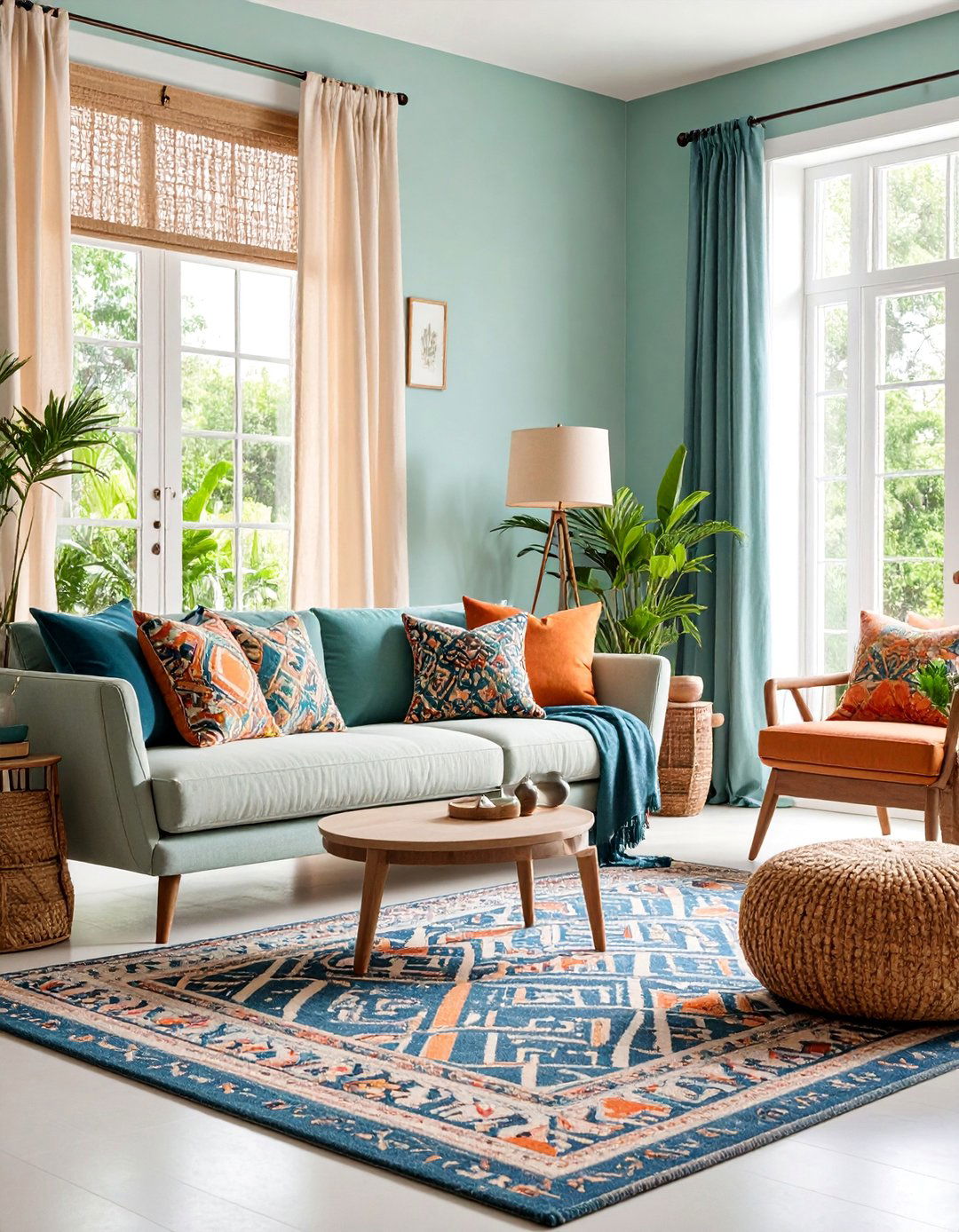
Combine different patterns thoughtfully through textiles and accessories, mixing geometric prints with organic motifs and traditional patterns with contemporary designs while maintaining visual cohesion through coordinated color palettes. Choose a large-scale pattern for the area rug, medium-scale patterns for throw pillows, and small-scale patterns for window treatments, ensuring scale variation prevents visual competition. Keep the color scheme consistent across all patterns to maintain harmony. This approach adds visual interest and personality while demonstrating transitional design's flexibility in accommodating diverse elements. The pattern mixing should feel intentional and sophisticated rather than chaotic, creating spaces that are both dynamic and restful, engaging and comfortable for daily living.
24. Metallic Accent Integration
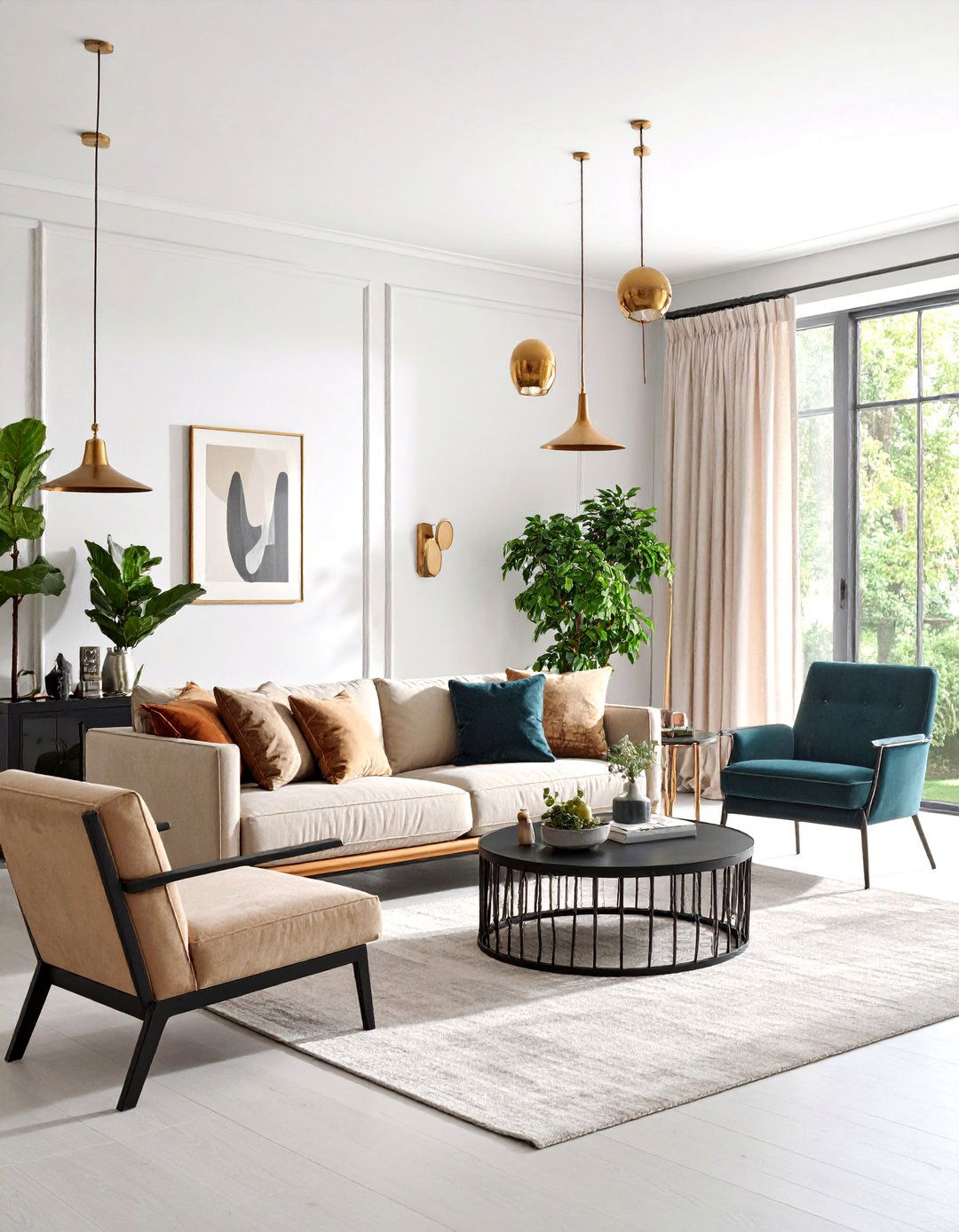
Incorporate mixed metals throughout the living space, combining brass, bronze, and black iron accents through lighting fixtures, hardware, and decorative accessories to add warmth and sophistication to neutral color schemes. Choose one metal as the dominant finish with others as supporting accents to maintain visual hierarchy. The metallic elements should feel integrated rather than scattered, appearing in multiple locations to create cohesion. This approach adds luxury and visual interest while maintaining the refined balance essential to transitional design. The mixed metals should complement rather than compete with each other, creating sophisticated layering that enhances the room's overall elegance while providing practical function through beautiful lighting and hardware.
25. Seasonal Flexibility Design
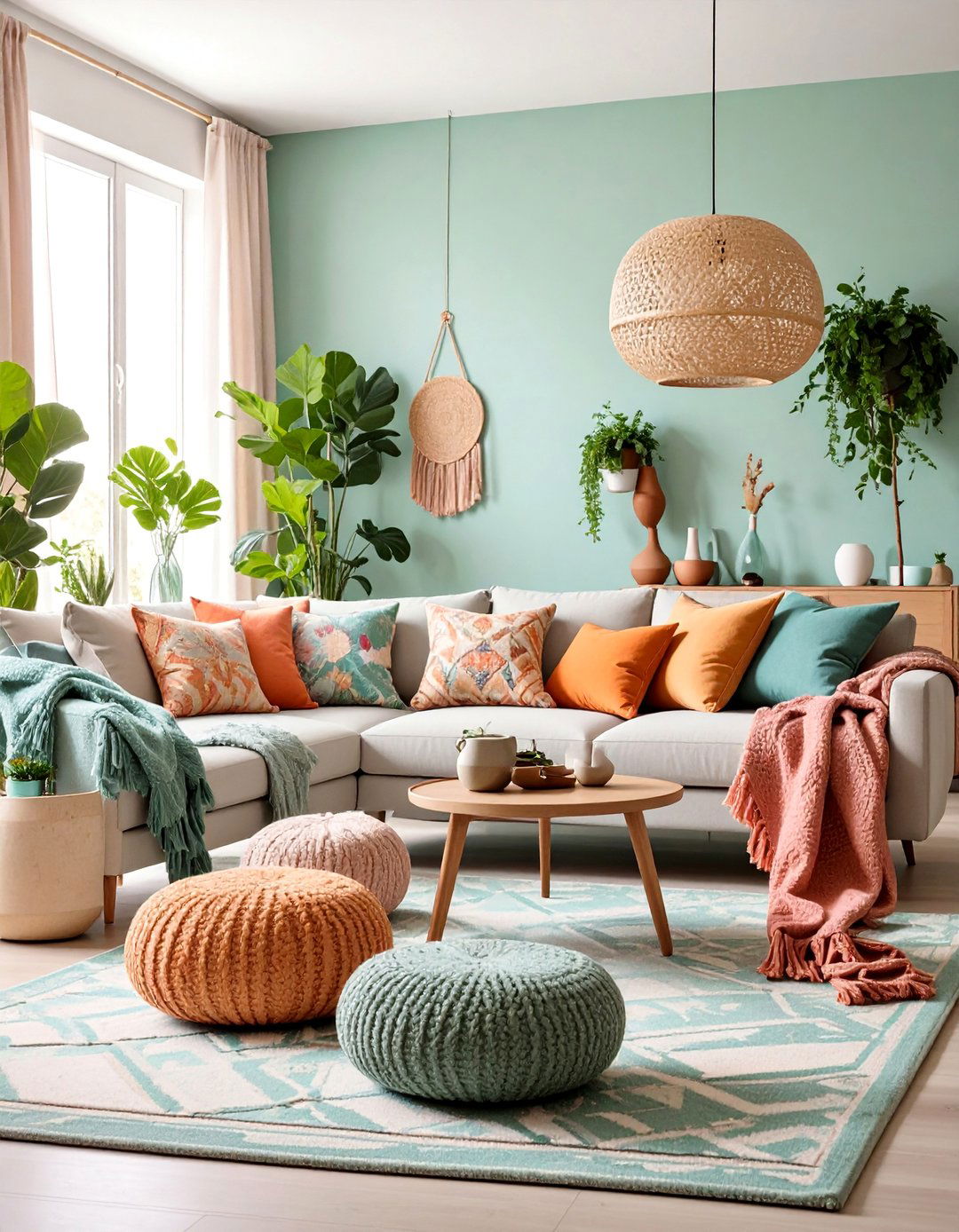
Design the living space with easily changeable elements that allow for seasonal updates while maintaining the core transitional aesthetic year-round through thoughtful selection of foundational pieces and adaptable accessories. Choose neutral upholstery and furniture that works in all seasons, then add seasonal interest through throw pillows, blankets, artwork, and decorative accessories that can be rotated throughout the year. This approach ensures the room feels fresh and current while maintaining its sophisticated foundation. The seasonal changes should feel natural and effortless, demonstrating how transitional design accommodates changing needs and preferences while preserving its timeless appeal and functional versatility for modern family living.
Conclusion:
Transitional living rooms offer the perfect solution for homeowners seeking timeless elegance with contemporary functionality. By blending traditional comfort with modern sophistication through careful attention to color, texture, furniture selection, and layout, these spaces create harmonious environments that adapt to changing needs while maintaining their refined appeal. The key lies in achieving balance between classic and contemporary elements, ensuring each room feels both current and enduring for years of comfortable, stylish living.



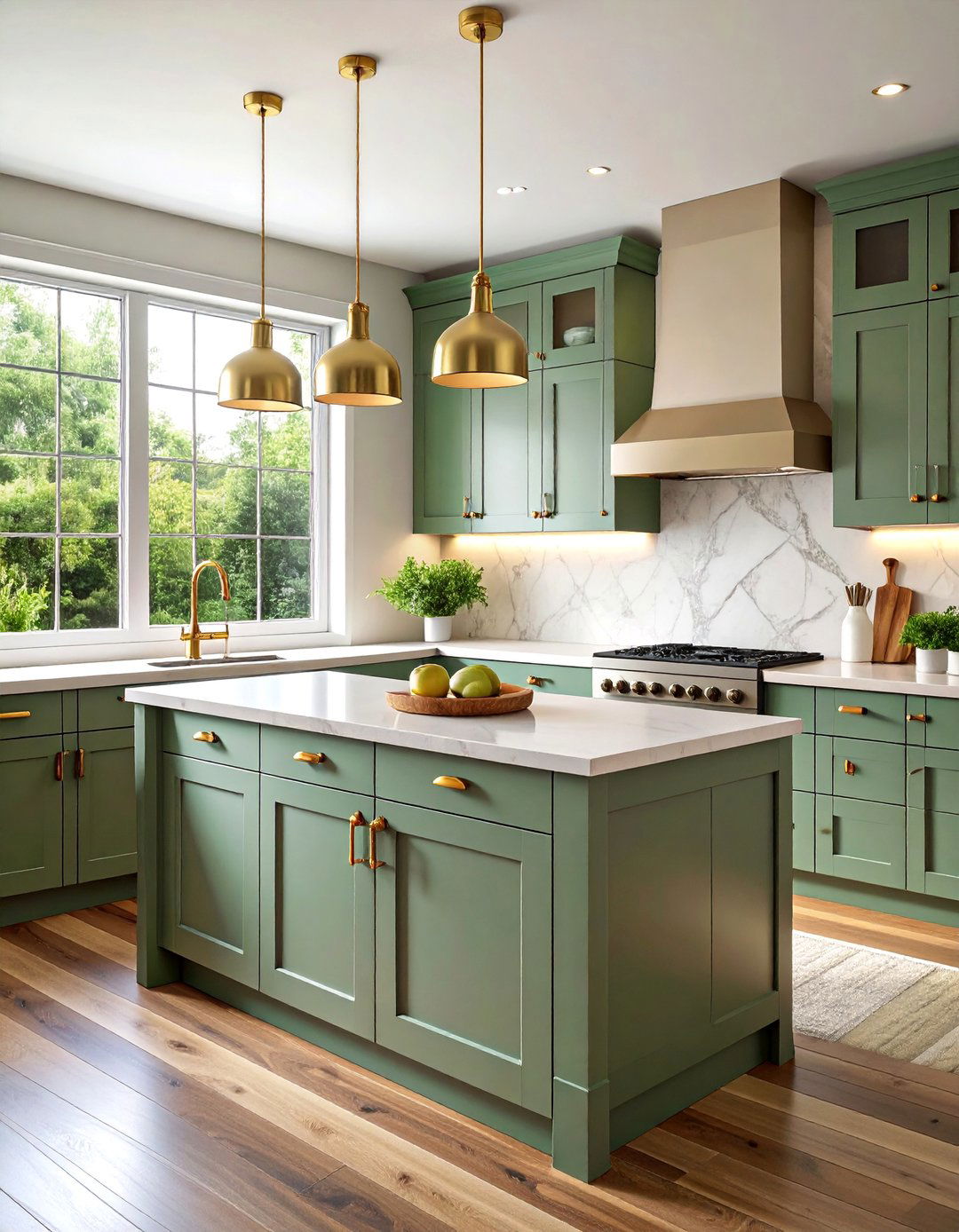
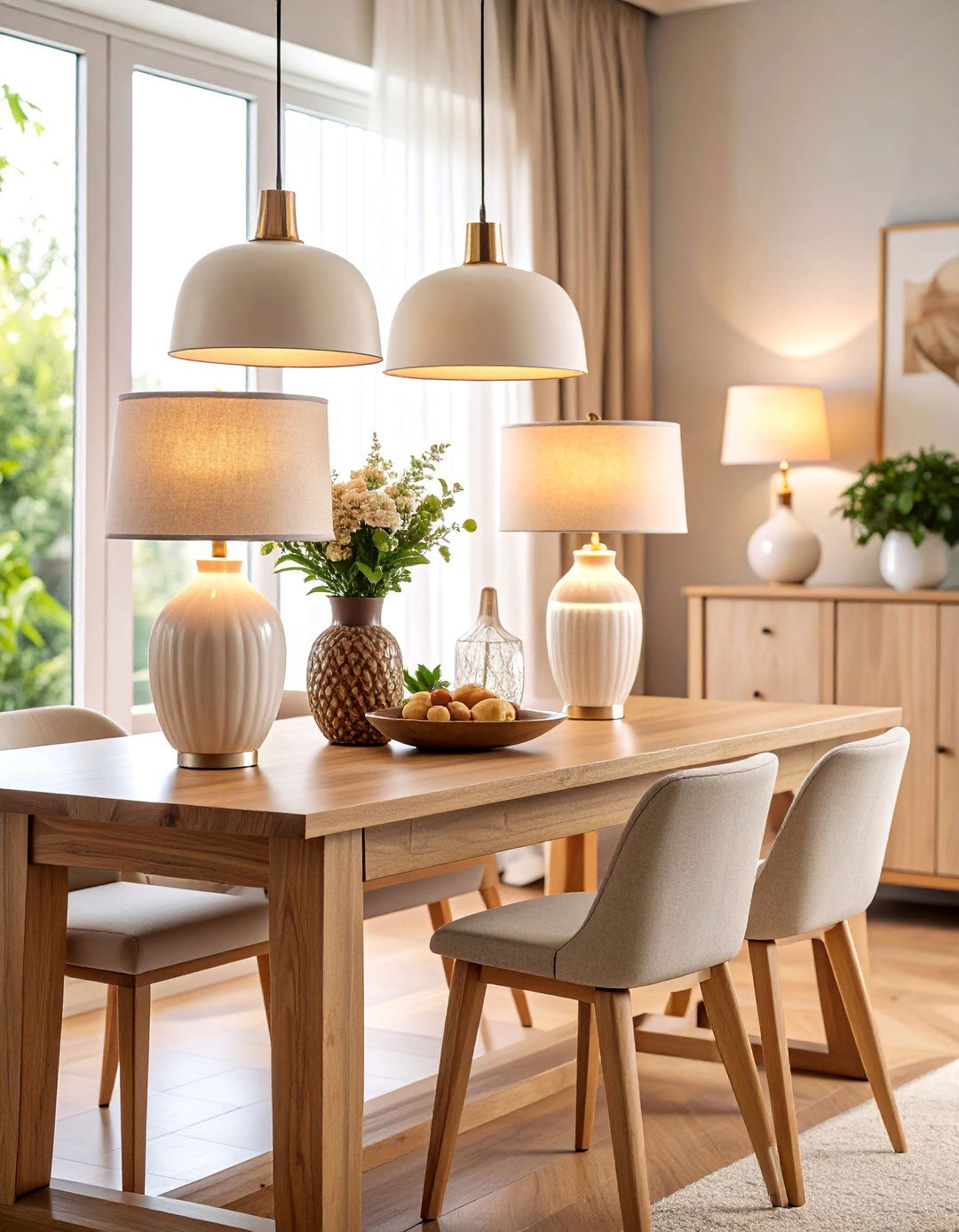
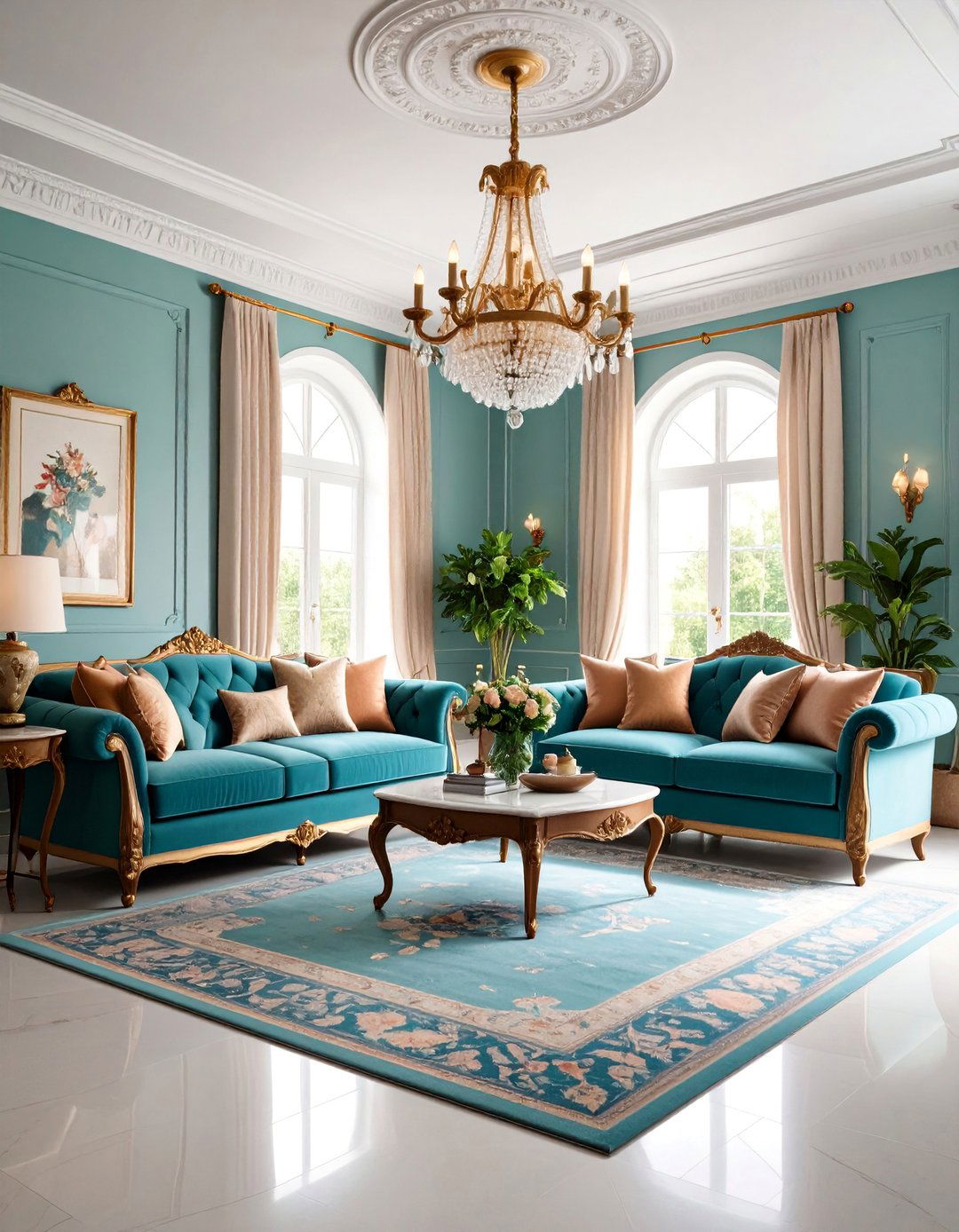



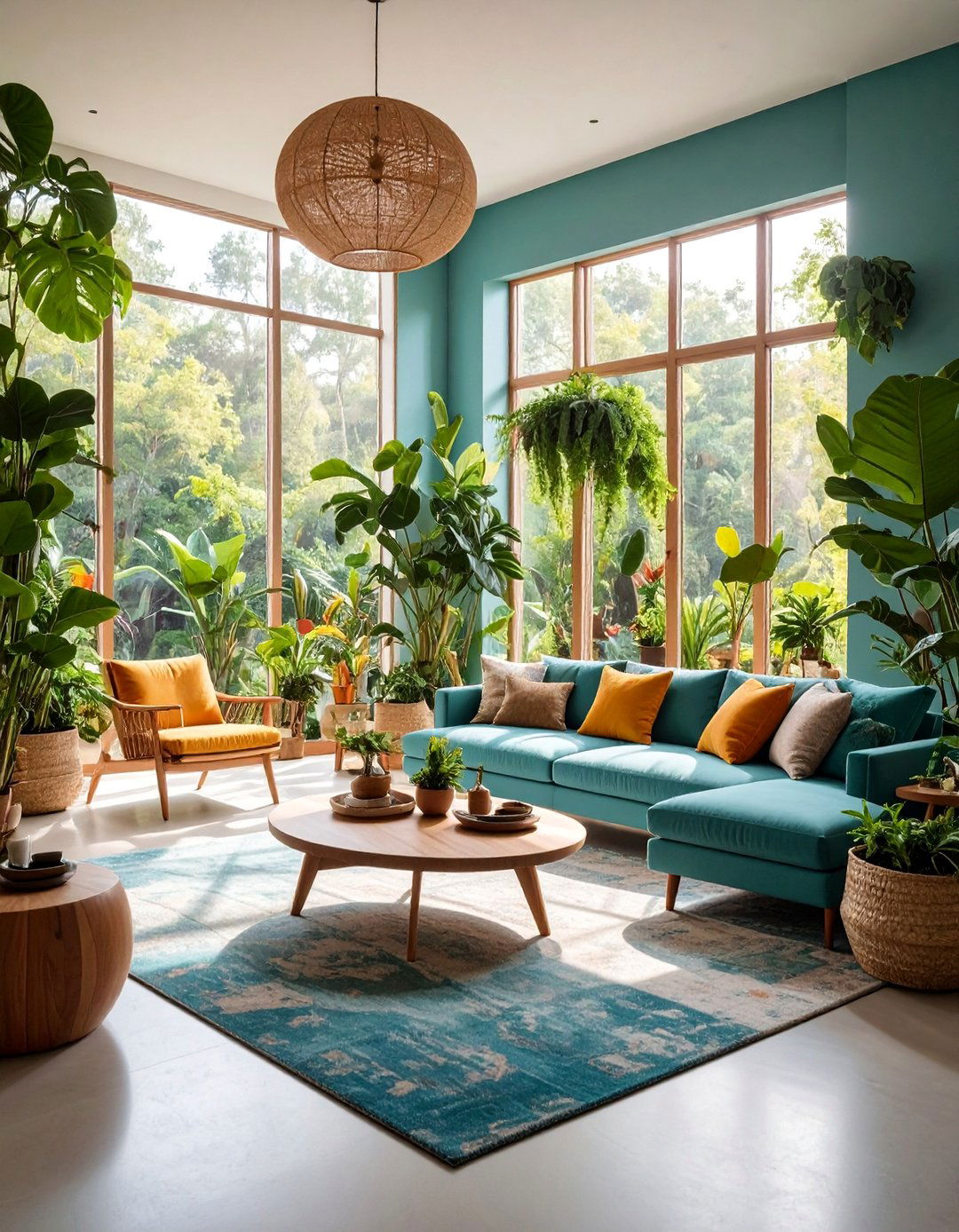
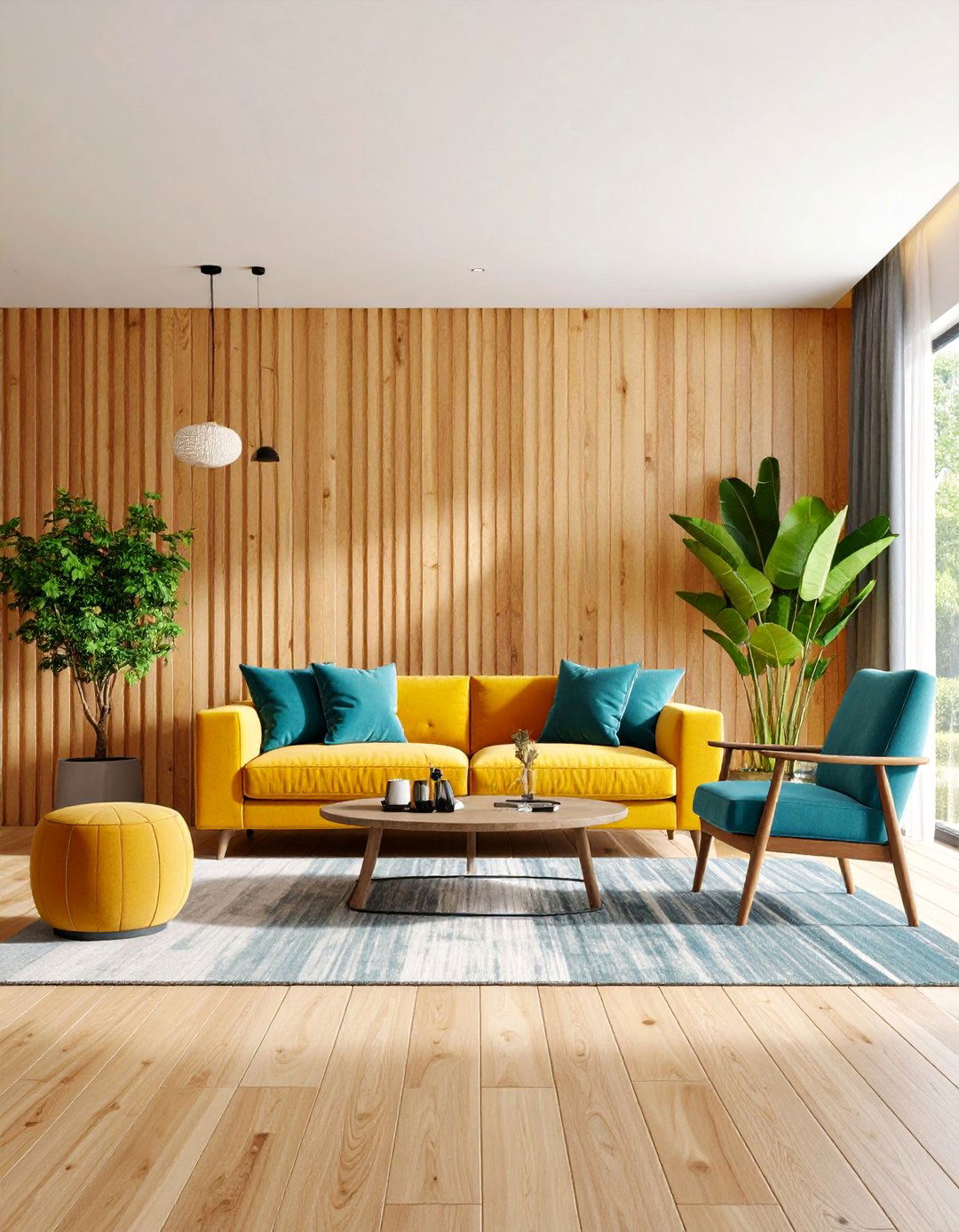
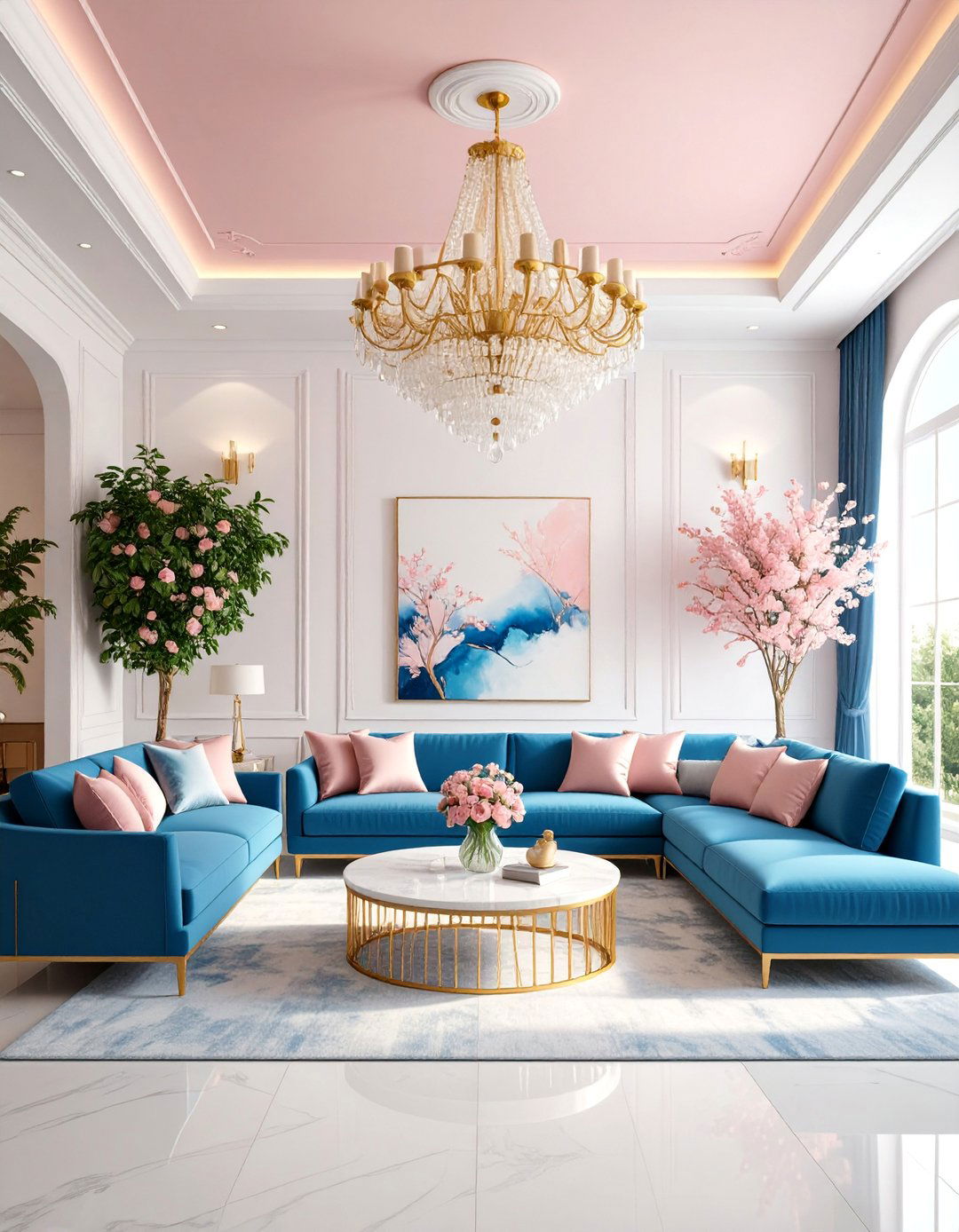
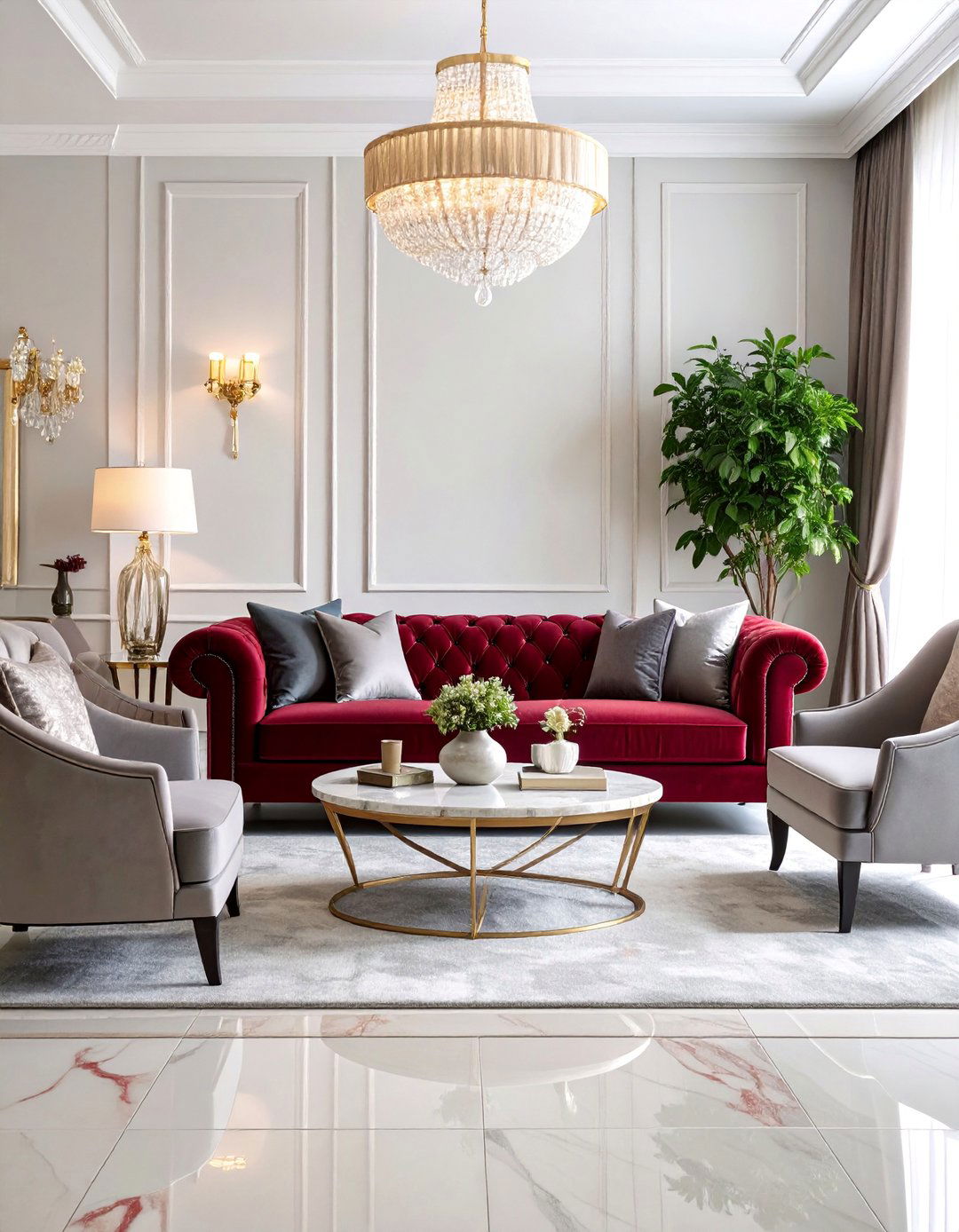

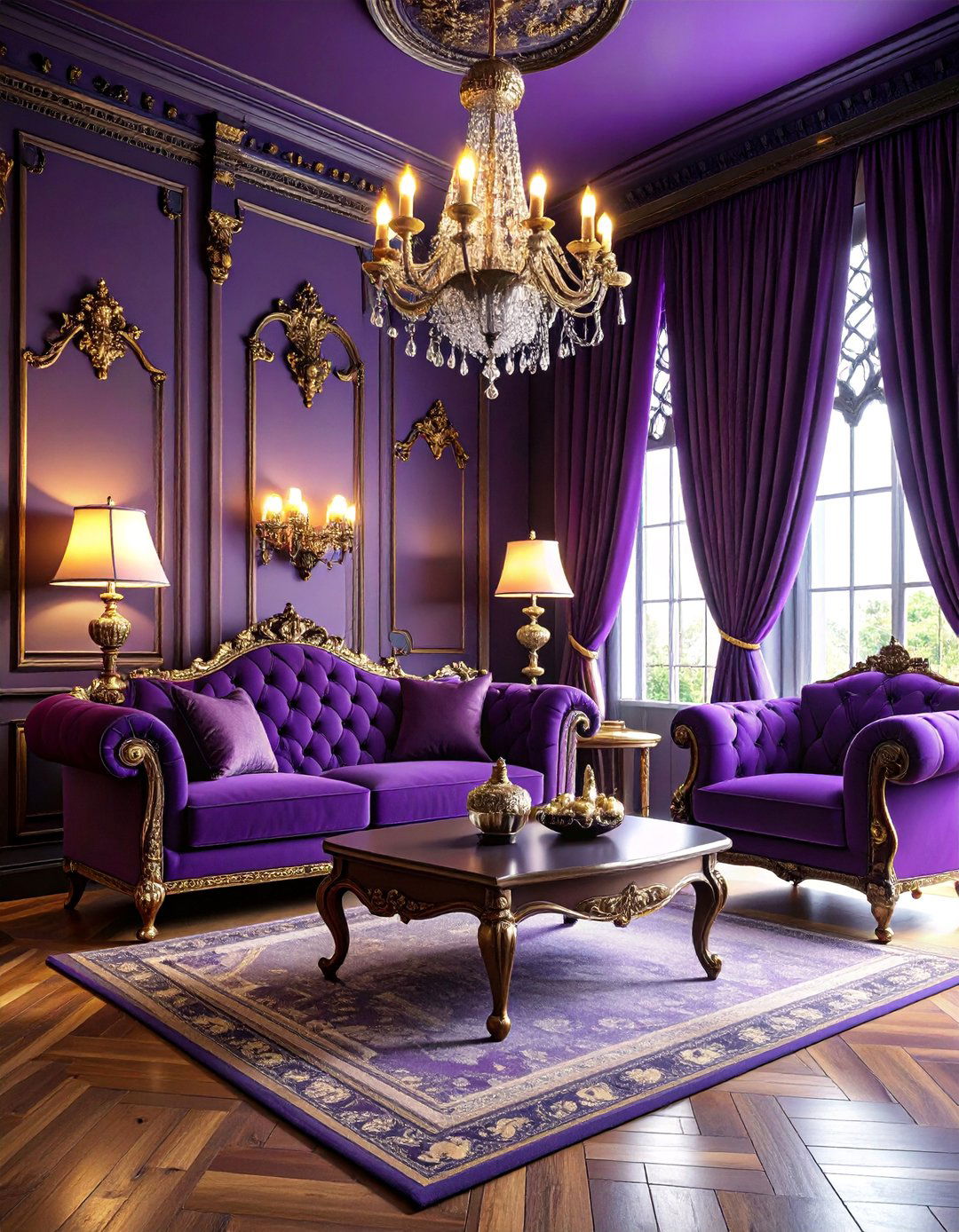
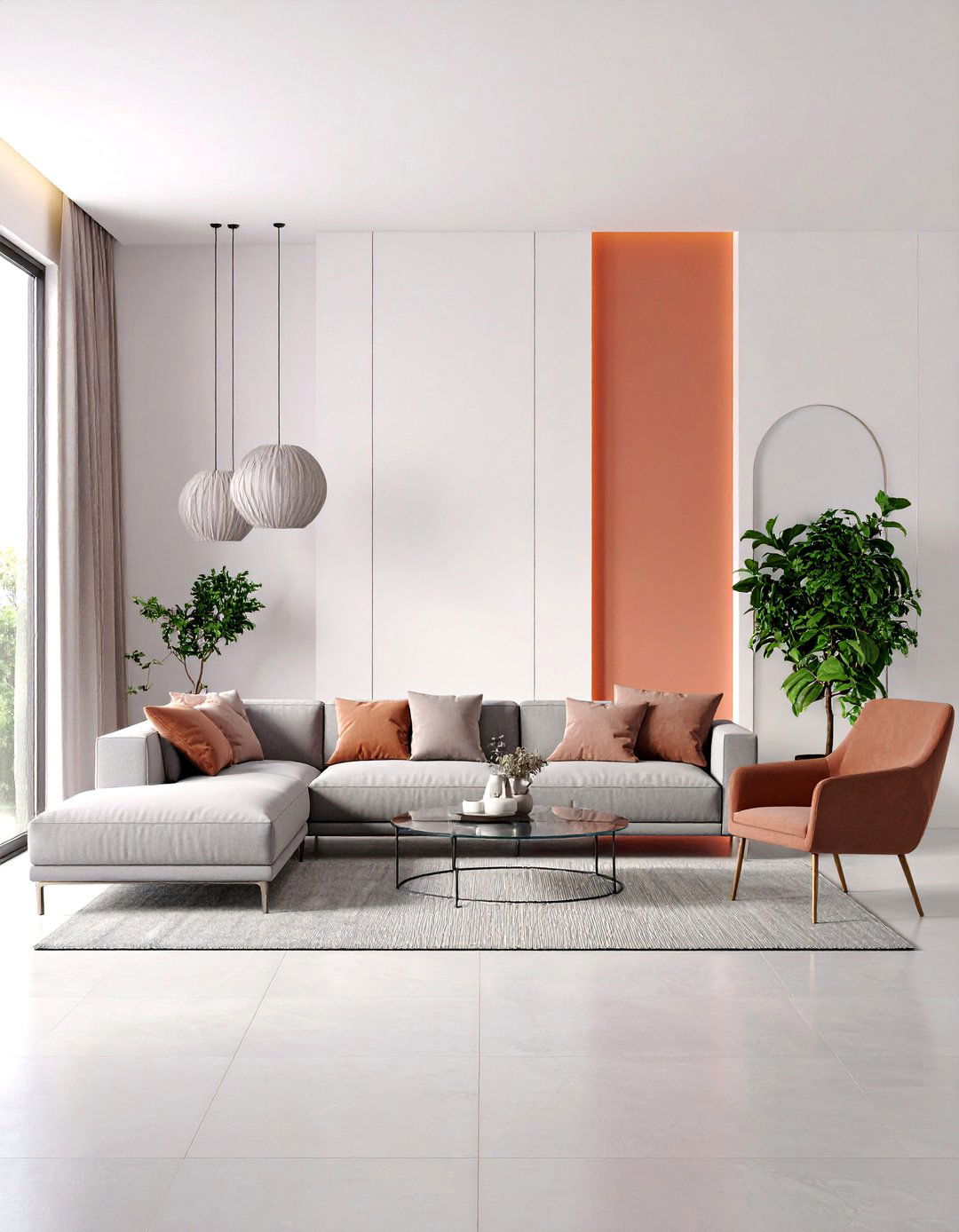
Leave a Reply